March 14 , 2024—Operationalizing trawl fisheries sustainability
 Trawl fisheries produce nearly 20 million mt of harvest annually, representing a globally important animal sourced food system. Yet, growing concern over habitat damage, bycatch, waste, and negative public perception regarding bottom trawl fisheries has increased pressure to improve these food systems. Suresh and Brad Harris (Alaska Pacific University) recently co-chaired a working group at the World Fisheries Congress in Seattle to assemble fisheries managers, fishing industry participants, ocean conservation organizations, and fisheries scientists to synthesize knowledge needs required by policy makers to operationalize advancements in trawl fisheries sustainability. The event was hosted by The UW Center for Sustaining Seafood. We identified key knowledge gaps currently facing managers and policy makers, and identified over 50 recommendations to operationalize trawl fishery sustainability advancements moving forward. This effort has solidified an international network spanning science, management, and conservation professionals seeking to develop solutions and advance action to improve bottom-towed fisheries sustainability. Ultimately, we will synthesize key insights from our group into a summary report with recommendations and practical guidance for actions to improve trawl fisheries sustainability.
Trawl fisheries produce nearly 20 million mt of harvest annually, representing a globally important animal sourced food system. Yet, growing concern over habitat damage, bycatch, waste, and negative public perception regarding bottom trawl fisheries has increased pressure to improve these food systems. Suresh and Brad Harris (Alaska Pacific University) recently co-chaired a working group at the World Fisheries Congress in Seattle to assemble fisheries managers, fishing industry participants, ocean conservation organizations, and fisheries scientists to synthesize knowledge needs required by policy makers to operationalize advancements in trawl fisheries sustainability. The event was hosted by The UW Center for Sustaining Seafood. We identified key knowledge gaps currently facing managers and policy makers, and identified over 50 recommendations to operationalize trawl fishery sustainability advancements moving forward. This effort has solidified an international network spanning science, management, and conservation professionals seeking to develop solutions and advance action to improve bottom-towed fisheries sustainability. Ultimately, we will synthesize key insights from our group into a summary report with recommendations and practical guidance for actions to improve trawl fisheries sustainability.
February 9, 2024—Celebrating student success!
 Congratulations to our PhD students Taylor Brown and Alex Koeberle for both jointly being recognized with the Best Student Oral Presentation Award for their presentations at the 2024 New York Chapter American Fisheries Society meeting! Taylor presented on her dissertation work on reconstructing over 50 years of native fish recruitment across the Great Lakes and Alex presented on his dissertation work on advancing native fish species restoration in NY inland waters. Thanks Taylor and Alex for your continued hard work and professionalism, your contributions are advancing aquatic ecosystem conservation. And, thanks to the 2024 NY AFS leadership for their continued support of the chapter and for fostering a welcoming and positive community for students, our next generation of aquatic scientists.
Congratulations to our PhD students Taylor Brown and Alex Koeberle for both jointly being recognized with the Best Student Oral Presentation Award for their presentations at the 2024 New York Chapter American Fisheries Society meeting! Taylor presented on her dissertation work on reconstructing over 50 years of native fish recruitment across the Great Lakes and Alex presented on his dissertation work on advancing native fish species restoration in NY inland waters. Thanks Taylor and Alex for your continued hard work and professionalism, your contributions are advancing aquatic ecosystem conservation. And, thanks to the 2024 NY AFS leadership for their continued support of the chapter and for fostering a welcoming and positive community for students, our next generation of aquatic scientists.
November 3, 2023—Supporting native fish species reintroductions through novel technology
 Hatchery stocking provides one important tool in reestablishing lost fish populations. Assessment of the survival of stocked fish is needed to support conservation goals, however directly observing the fate of stocked juvenile fish has remained a challenge in the field. In a recent paper in Scientific Reports led by PhD student, Alexander Koeberle, we combine small acoustic tags and whole lake monitoring to estimate survival of stocked juvenile fish. In a collaboration with the NY Department of Environmental Conservation, Cornell University, and USGS to restore extirpated native Cisco (Coregonus artedi) in Keuka Lake to improve ecosystem resilience, we show that tagging technology now exists to achieve survival estimates of fish as small as 6g in size. Results from Alex’s work are useful for native cisco restoration in NY and the approaches we demonstrate are applicable across a wide range of waterbodies and fish species. Photo credit: M. Chalupnicki.
Hatchery stocking provides one important tool in reestablishing lost fish populations. Assessment of the survival of stocked fish is needed to support conservation goals, however directly observing the fate of stocked juvenile fish has remained a challenge in the field. In a recent paper in Scientific Reports led by PhD student, Alexander Koeberle, we combine small acoustic tags and whole lake monitoring to estimate survival of stocked juvenile fish. In a collaboration with the NY Department of Environmental Conservation, Cornell University, and USGS to restore extirpated native Cisco (Coregonus artedi) in Keuka Lake to improve ecosystem resilience, we show that tagging technology now exists to achieve survival estimates of fish as small as 6g in size. Results from Alex’s work are useful for native cisco restoration in NY and the approaches we demonstrate are applicable across a wide range of waterbodies and fish species. Photo credit: M. Chalupnicki.
October 16, 2023—Suresh was appointed as the NY state representative to the Atlantic States Marine Fisheries Commission CESS
 Suresh was appointed by the NY Department of Environmental Conservation to serve as the NY State representative on the Atlantic States Marine Fisheries Commission Committee on Economic and Social Science. As a committee member, Dr. Sethi will contribute to data analyses and respond to Commission requests for guidance related to the socioeconomic dynamics of the vibrant fisheries and fishing communities along the U.S. Atlantic coast.
Suresh was appointed by the NY Department of Environmental Conservation to serve as the NY State representative on the Atlantic States Marine Fisheries Commission Committee on Economic and Social Science. As a committee member, Dr. Sethi will contribute to data analyses and respond to Commission requests for guidance related to the socioeconomic dynamics of the vibrant fisheries and fishing communities along the U.S. Atlantic coast.
July 1, 2023—Our new paper shows that marine reserves that move over time hold promise for dual ocean habitat + fisheries management
 Spatial closures are an important tool used to protect sensitive habitats in the ocean; however, once implemented, the location of marine reserves are often fixed in space forever. Recent work led Cornell PhD student Anna Poulton shows that in many scenarios dynamic spatial closures–which change in location over time–show promise in achieving strong habitat protection and fisheries harvest performance compared to fixed spatial closures. Using cutting edge optimization techniques, Anna’s work combines spatially explicit fishery models with habitat-impact recovery models to assess performance of dynamic vs. fixed spatial closures. This innovative work was recognized as the Editor’s pick for the June 2023 issue of the Canadian Journal of Fisheries and Aquatic Sciences.
Spatial closures are an important tool used to protect sensitive habitats in the ocean; however, once implemented, the location of marine reserves are often fixed in space forever. Recent work led Cornell PhD student Anna Poulton shows that in many scenarios dynamic spatial closures–which change in location over time–show promise in achieving strong habitat protection and fisheries harvest performance compared to fixed spatial closures. Using cutting edge optimization techniques, Anna’s work combines spatially explicit fishery models with habitat-impact recovery models to assess performance of dynamic vs. fixed spatial closures. This innovative work was recognized as the Editor’s pick for the June 2023 issue of the Canadian Journal of Fisheries and Aquatic Sciences.
May 31, 2023—Next generation fisheries sustainability scientists. Congratulations Dr. Kimberly Fitzpatrick and Dr. Scott Smeltz!
 Congratulations to our students, now newly hooded Dr. Kimberly Fitzpatrick and Dr. Scott Smeltz for successfully defending their PhD dissertations at Cornell University! Kimberly has advanced multispecies stock assessment and genetic tools for fisheries monitoring that are supporting Lake Ontario Chinook Salmon management, one of the largest recreational fisheries in the world. Scott has advanced novel approaches to assess and manage seafloor impacts from commercial fishing. The modeling approaches he helped develop are now utilized by both the North Pacific and New England Fishery Management Councils to manage impacts to Essential Fish Habitat, as mandated under U.S. ocean law. Many thanks go to the Fisheries Aquatic Science & Technology Lab at Alaska Pacific University for co-hosting Scott during his PhD. I am humbled to have had the opportunity to work with Kimberly and Scott and will look forward to seeing their positive impacts on ocean ecosystem sustainability as they progress through their careers!
Congratulations to our students, now newly hooded Dr. Kimberly Fitzpatrick and Dr. Scott Smeltz for successfully defending their PhD dissertations at Cornell University! Kimberly has advanced multispecies stock assessment and genetic tools for fisheries monitoring that are supporting Lake Ontario Chinook Salmon management, one of the largest recreational fisheries in the world. Scott has advanced novel approaches to assess and manage seafloor impacts from commercial fishing. The modeling approaches he helped develop are now utilized by both the North Pacific and New England Fishery Management Councils to manage impacts to Essential Fish Habitat, as mandated under U.S. ocean law. Many thanks go to the Fisheries Aquatic Science & Technology Lab at Alaska Pacific University for co-hosting Scott during his PhD. I am humbled to have had the opportunity to work with Kimberly and Scott and will look forward to seeing their positive impacts on ocean ecosystem sustainability as they progress through their careers!
March 1, 2023—Podcast episode on our work using AI to find ghost dams
 Dams block the movement of migratory fish and represent one of the greatest threats to freshwater biodiversity. Over two centuries of dam building have left a legacy of tens of thousands of stream barriers across North America alone. We know how to restore watershed connectivity by removing unsafe and unused dams, but amazingly, we lack even basic information on where the dams are. ScienceLine recently published a podcast on our work outlining the challenges with filling in dam inventories to support watershed management and featured our recent Journal of Environmental Management paper using Machine Learning to advance digital methods to identify ‘ghost dams’. Harnessing AI to fill in dam inventories across the landscape will inform conservation planning at scale and help move the needle on restoring freshwater connectivity.
Dams block the movement of migratory fish and represent one of the greatest threats to freshwater biodiversity. Over two centuries of dam building have left a legacy of tens of thousands of stream barriers across North America alone. We know how to restore watershed connectivity by removing unsafe and unused dams, but amazingly, we lack even basic information on where the dams are. ScienceLine recently published a podcast on our work outlining the challenges with filling in dam inventories to support watershed management and featured our recent Journal of Environmental Management paper using Machine Learning to advance digital methods to identify ‘ghost dams’. Harnessing AI to fill in dam inventories across the landscape will inform conservation planning at scale and help move the needle on restoring freshwater connectivity.
February 16, 2023—Congratulations to Jessica Best who is the new President Elect of the New York Chapter of the American Fisheries Society!
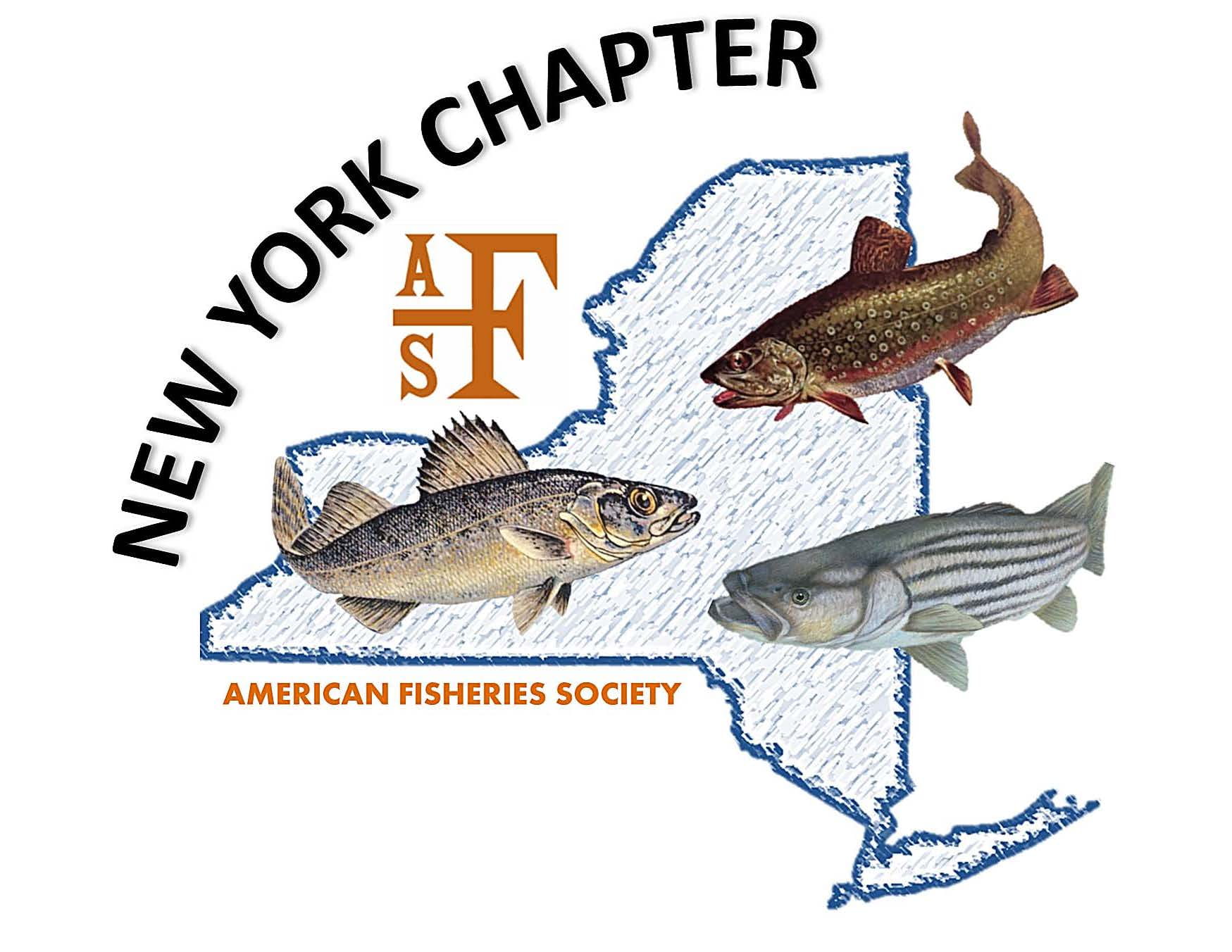 Jess was elected at the recent NY AFS meeting in Stonybrook to serve as the incoming President Elect of the Chapter. She will spend the next year as President Elect before transitioning to President in the following year. In addition to being a M.S. graduate student where her research is addressing Hudson River fisheries ecology and management, Jess is a parent, a full time Biologist in the Hudson River Estuary Program, and a science educator. Thank you in advance for your service to NY AFS, Jess. We’re inspired by your energy and your contributions!
Jess was elected at the recent NY AFS meeting in Stonybrook to serve as the incoming President Elect of the Chapter. She will spend the next year as President Elect before transitioning to President in the following year. In addition to being a M.S. graduate student where her research is addressing Hudson River fisheries ecology and management, Jess is a parent, a full time Biologist in the Hudson River Estuary Program, and a science educator. Thank you in advance for your service to NY AFS, Jess. We’re inspired by your energy and your contributions!
December 11, 2022—Financing global biodiversity: COP15 of the Convention on Biological Diversity in Montreal
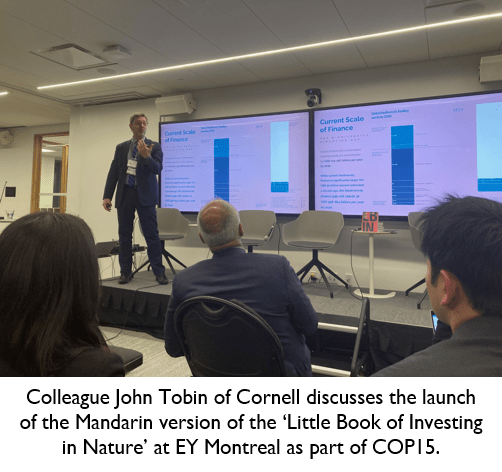 COP15 is in action in Montreal! I was fortunate to spend some time in Montreal attending the CBD COP15 and met many inspiring people working to finance global biodiversity conservation. From nonfungible tokens for ocean sustainability management, to a new 300M euro investment fund for nature positive fashion supply chains launched by Kering and L’Occitaine, to a new nature positive tourism alliance. I’m excited about the conservation finance space and the potential to both align business practices with ecosystem integrity and to mobilize financial resources for biodiversity conservation globally. Our ‘Financing Nature‘ report estimates on the global biodiversity funding gap can help inform country level targets for biodiversity financing. I look forward to 2023 and beyond in continuing to engage in the ocean conservation finance space–making business as usual nature positive!
COP15 is in action in Montreal! I was fortunate to spend some time in Montreal attending the CBD COP15 and met many inspiring people working to finance global biodiversity conservation. From nonfungible tokens for ocean sustainability management, to a new 300M euro investment fund for nature positive fashion supply chains launched by Kering and L’Occitaine, to a new nature positive tourism alliance. I’m excited about the conservation finance space and the potential to both align business practices with ecosystem integrity and to mobilize financial resources for biodiversity conservation globally. Our ‘Financing Nature‘ report estimates on the global biodiversity funding gap can help inform country level targets for biodiversity financing. I look forward to 2023 and beyond in continuing to engage in the ocean conservation finance space–making business as usual nature positive!
October 25, 2022—Will invasive round goby adapt to coastal marine environments in the Northeast?
The round goby (Neogobius melanostomus) is radiating out of the Great Lakes basin and spreading across the Midwest and Northeast of the U.S. and into Canada. This small benthic fish can reach high biomass quickly and plays a role as both prey and predator within invaded food webs. With a natal range in freshwater and brackish ecosystems in the Ponto-Caspian region, round goby introduced to North America have now reached the coastal Hudson River. If they can tolerate nearshore marine salinities, round goby could spread across vast areas of coastal ecosystems. In cooperation with the NY Department of Environmental Conservation-Cornell joint Hudson River Estuary Program, grad student Kelsey Alvarez del Castillo is investigating salinity tolerance of round goby. After lots of hard work and pilot testing, her lab experiment is up and running and the goby look happy. Through her graduate work, Kelsey will be providing much needed information on the spread potential for this fish on the move.
September 22, 2022—How many Walrus are in the sea?
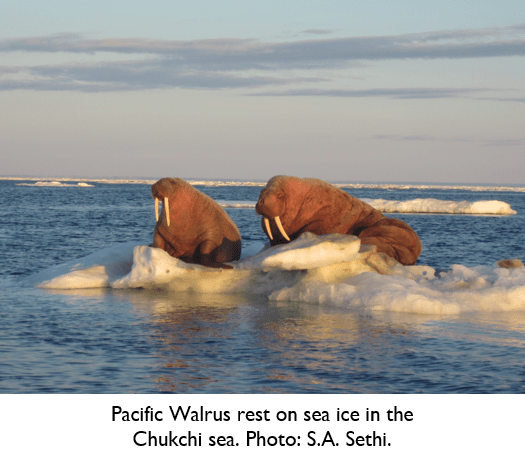 Pacific Walrus (Odobenus rosmarus divergens) roam across the arctic oceans and are an important cultural resource for many indigenous communities. Walrus rely on sea ice for a free ride and rest pad as they forage for benthic clams across vast swaths of the seafloor. As sea ice declines, Walrus may need to increase reliance on shore-based foraging strategies. This may ultimately impact this species’ population trajectory. To inform the current status of the Pacific Walrus population and inform potential future management actions, we implemented a cutting edge genetic mark recapture study to estimate abundance and survival of Walrus. Published in the journal Marine Ecology Progress Series, this 10yr+ project included collaboration across many Federal, State, academic, and international partners. Spearheaded by Dr. Bill Beatty at the USGS, mark recapture estimates indicate approximately 256,000 Walrus at large presently; as sea ice continues to decline throughout the arctic, long term population trends of Pacific Walrus are uncertain. Thus, continued range-wide monitoring of Walrus will be core information needed to track the status of this fascinating species as oceans warm further.
Pacific Walrus (Odobenus rosmarus divergens) roam across the arctic oceans and are an important cultural resource for many indigenous communities. Walrus rely on sea ice for a free ride and rest pad as they forage for benthic clams across vast swaths of the seafloor. As sea ice declines, Walrus may need to increase reliance on shore-based foraging strategies. This may ultimately impact this species’ population trajectory. To inform the current status of the Pacific Walrus population and inform potential future management actions, we implemented a cutting edge genetic mark recapture study to estimate abundance and survival of Walrus. Published in the journal Marine Ecology Progress Series, this 10yr+ project included collaboration across many Federal, State, academic, and international partners. Spearheaded by Dr. Bill Beatty at the USGS, mark recapture estimates indicate approximately 256,000 Walrus at large presently; as sea ice continues to decline throughout the arctic, long term population trends of Pacific Walrus are uncertain. Thus, continued range-wide monitoring of Walrus will be core information needed to track the status of this fascinating species as oceans warm further.
June 22, 2022—Unpacking the life history consequences of stream barriers for migratory fish
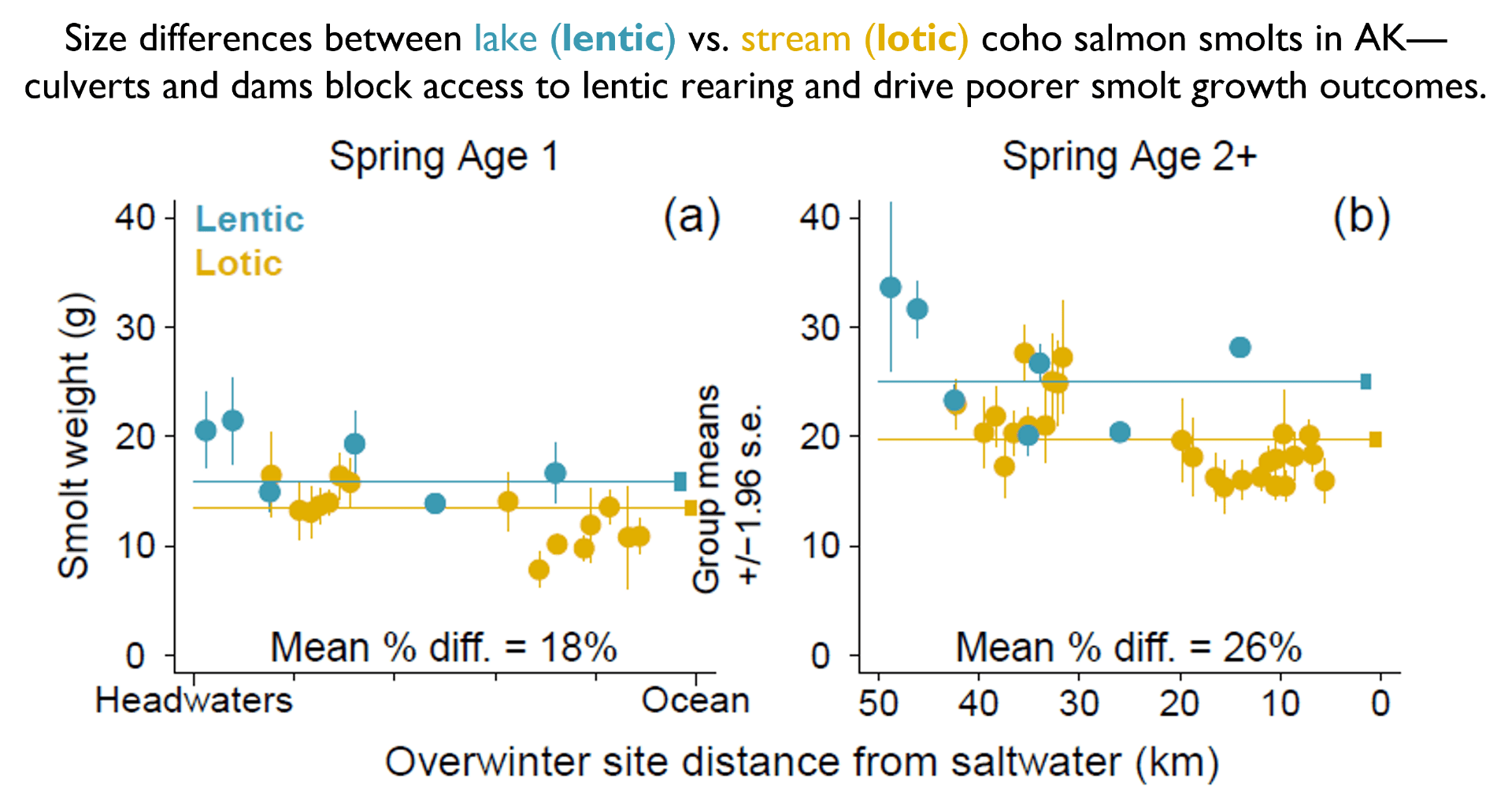
In our new Ecosphere paper we show that stream connectivity loss drives lower smolt size in juvenile Pacific salmon by restricting access to high growth rearing habitats. We tracked PIT-tagged juvenile Coho salmon (Oncoryhnchus kisutch) throughout the Big Lake drainage in coastal Cook Inlet Alaska over multiple years, assessing both habitat use and growth outcomes. We found juvenile Coho salmon that migrated to headwater lakes to overwinter were 26% larger by weight as smolts compared to fish that stayed in moving water throughout freshwater rearing. Unfortunately, headwater lake-type rearing habitats are often at high risk to blockages by culverts and dams. By blocking access to lake-type overwinter habitats, culverts and dams restrict high-growth strategies. Our study provides insights into how stream barriers affect the life history and ecology of migratory fish. Exciting to see our Big Lake results are informing stream barrier mitigation in AK! Big thanks to the many collaborators on this project, spanning Alaska Pacific University, UA-Fairbanks, USFWS Alaska Region, and the USGS AK Science Center.
April 20, 2022—We welcome two new members to the lab group!

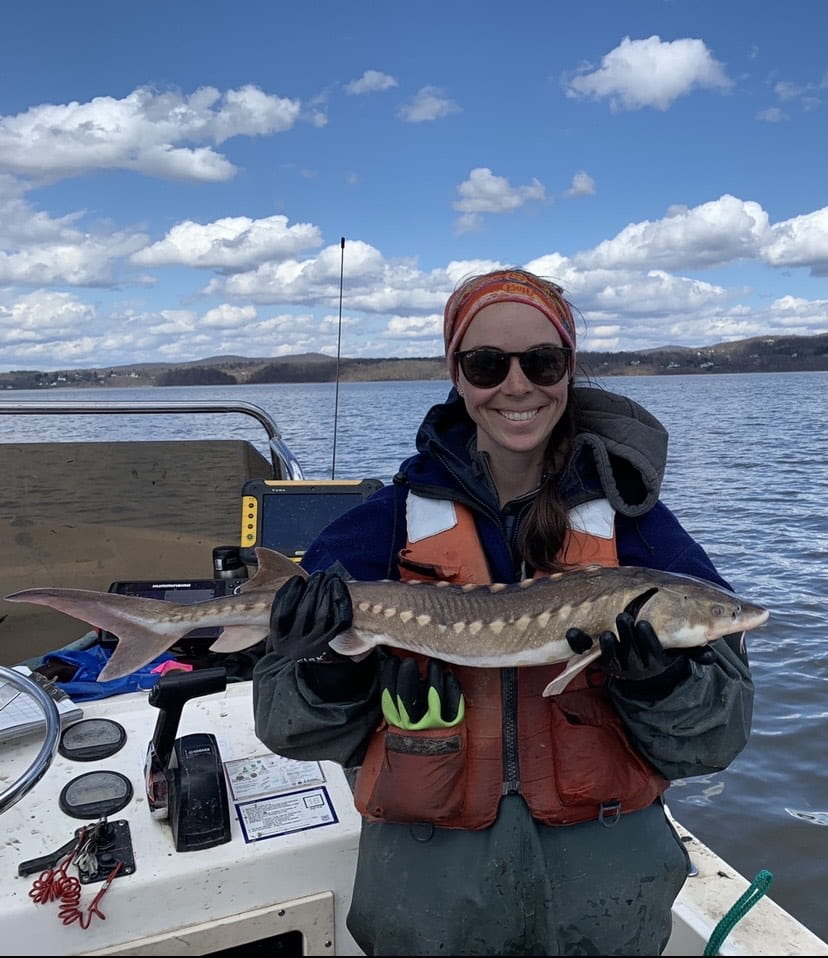
We welcome Jess Best and Kelsey Alvarez del Castillo to the lab group. Both Jess and Kelsey are pursuing M.S. degrees and will be working on Hudson River ecology and fisheries management. Jess will be assessing mycobateria dynamics in striped bass; she is also a full time biologist in the Cornell-NY Department of Environmental Conservation Hudson River Estuary Fisheries Program. Kelsey will be studying the invasion ecology of the newest fish invader to the Hudson River, round goby. We are delighted to have Jess and Kelsey as part of the group!
February 21, 2022—Reducing adverse impacts of Amazon hydropower expansion
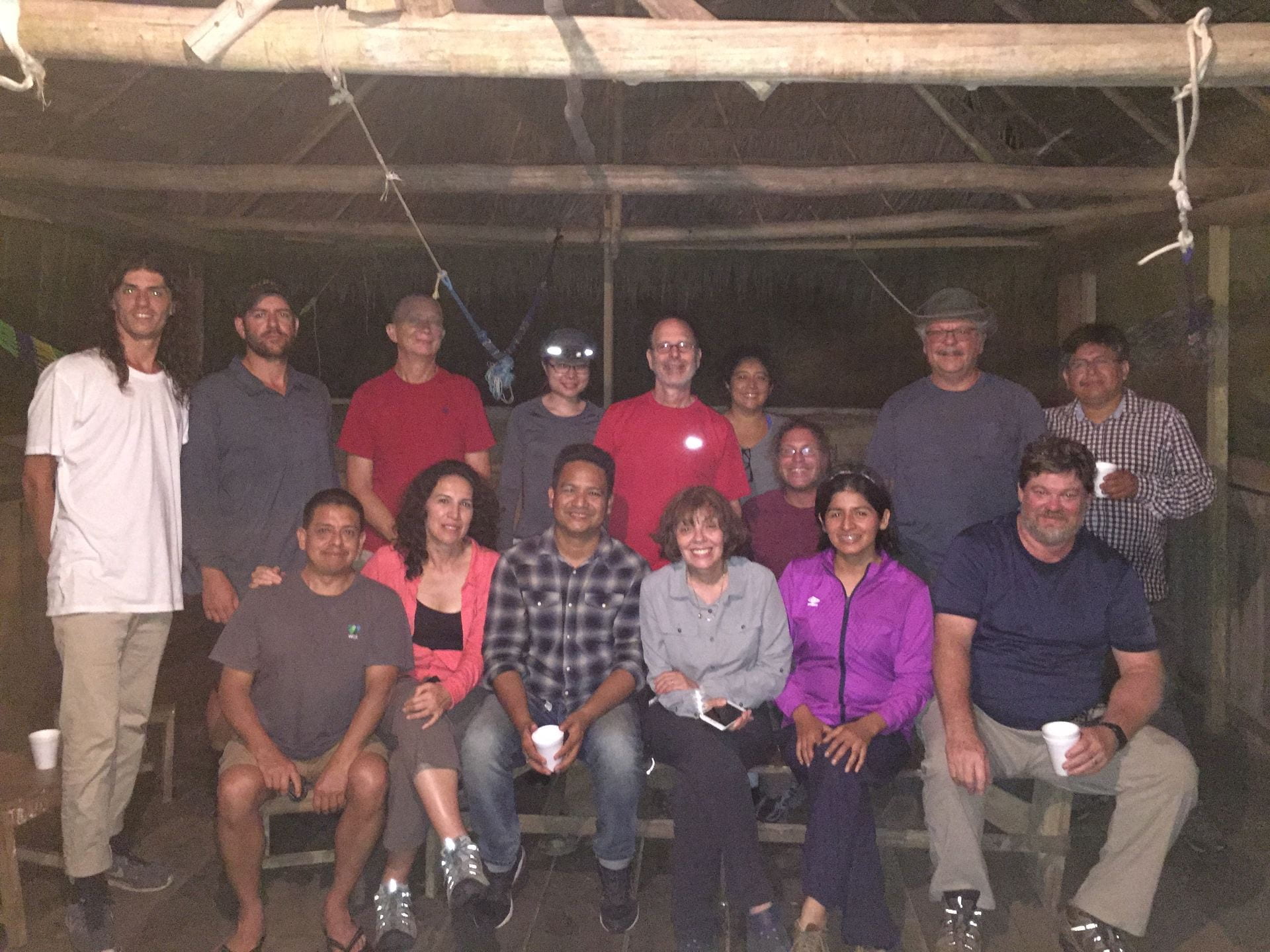 Our new Science paper combines computer science and ecology to manage ecosystem impacts from Amazon hydropower expansion. With over 350 large hydropower projects currently proposed in the Earth’s most biodiverse freshwater riverscape, strategic planning will be critical for balancing energy benefits with ecosystem impacts. Led by Alex Flecker and Carla Gomes at Cornell we implement multiobjective optimization for hydropower planning at unprecedented scales. We find a set of four key takeaways from this international, pan-Amazon collaboration: 1) Uncoordinated hydropower expansion has resulted in foregone ecosystem services in the Amazon. 2) Effective hydropower planning requires multiple criteria and pan-Amazon scales. 3) Multiobjective optimization can identify particularly detrimental dam projects that could be taken off the table. 4) Optimization analyses show international coordination is key to minimize ecosystem impacts from hydropower proliferation, but computational tools now allow for river connectivity optimization at continental scales. Thanks to the Cornell Atkinson Center for Sustainability and NSF for funding this work. ‘Humbled to be part of this amazing team of collaborators including folks across the Amazon and many institutions!
Our new Science paper combines computer science and ecology to manage ecosystem impacts from Amazon hydropower expansion. With over 350 large hydropower projects currently proposed in the Earth’s most biodiverse freshwater riverscape, strategic planning will be critical for balancing energy benefits with ecosystem impacts. Led by Alex Flecker and Carla Gomes at Cornell we implement multiobjective optimization for hydropower planning at unprecedented scales. We find a set of four key takeaways from this international, pan-Amazon collaboration: 1) Uncoordinated hydropower expansion has resulted in foregone ecosystem services in the Amazon. 2) Effective hydropower planning requires multiple criteria and pan-Amazon scales. 3) Multiobjective optimization can identify particularly detrimental dam projects that could be taken off the table. 4) Optimization analyses show international coordination is key to minimize ecosystem impacts from hydropower proliferation, but computational tools now allow for river connectivity optimization at continental scales. Thanks to the Cornell Atkinson Center for Sustainability and NSF for funding this work. ‘Humbled to be part of this amazing team of collaborators including folks across the Amazon and many institutions!
January 4, 2022—PhD student Taylor Brown co-leads a grant to study Coregonine life history across all 5 Laurentian Great Lakes
Congratulations to PhD student Taylor Brown for co-leading a successful competitive grant with PI Dr. Andrew Honsey of the Great Lakes Science Center for a large cross-Great Lake study on Coregonine life history drivers. This project to be funded by the Great Lakes Fisheries Commission will synthesize spatially and temporally explicit data on Coregonines to inform management of these critical native forage fish. Our team is large, including collaborators spanning all 5 Laurentian Great Lakes from universities, tribes, and U.S. and Canadian state and federal agencies. Nice work Taylor and Andrew!
November 8, 2021—Machine learning to identify ‘ghost’ dams in river networks
 Dams fundamentally change rivers by reducing connectivity, impacting the movement of water, sediments, and fish. Dam removal is gaining traction but existing dam inventories are incomplete. In a project led by Dr. Brian Buchanan and funded by the NY Water Resources Institute, we developed an approach using digital stream networks and random forest classifiers to automate small dam identification. Our approach published in the Journal of Environmental Management achieved 90% accuracy in predicting small dam locations. Results from two test watersheds in the Hudson River indicate 4X and 15X more ‘ghost’ dams exist than inventoried dams. In these cases, river connectivity is greatly over-estimated when assessed using existing dam inventories. We hope this work will facilitate ‘desktop’ dam inventories that can be used to guide field inventories and help complete dam catalogs to support strategic river ecosystem restoration.
Dams fundamentally change rivers by reducing connectivity, impacting the movement of water, sediments, and fish. Dam removal is gaining traction but existing dam inventories are incomplete. In a project led by Dr. Brian Buchanan and funded by the NY Water Resources Institute, we developed an approach using digital stream networks and random forest classifiers to automate small dam identification. Our approach published in the Journal of Environmental Management achieved 90% accuracy in predicting small dam locations. Results from two test watersheds in the Hudson River indicate 4X and 15X more ‘ghost’ dams exist than inventoried dams. In these cases, river connectivity is greatly over-estimated when assessed using existing dam inventories. We hope this work will facilitate ‘desktop’ dam inventories that can be used to guide field inventories and help complete dam catalogs to support strategic river ecosystem restoration.
October 19, 2021—Ithaca invests in sustainability
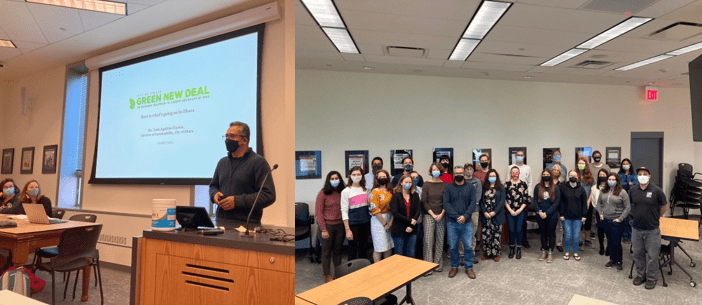
We were fortunate to have Dr. Luis Aguirre-Torres, Director of Sustainability for Ithaca NY, speak to our NTRES 6140 Conservation Controversies grad seminar. Under Luis’ vision, Ithaca is launching a Green New Deal that is participatory, respects equity & justice, leverages innovative climate finance, and looks to enact durable long term solutions to address our city’s climate footprint. Ithaca is lucky to have Dr. Aguirre-Torres’ experience and expertise. Here’s to hoping every town gets a Sustainability Office to help make the transition to address climate change in a durable and equitable fashion. Thanks to DNRE PhD student Stephanie Figary for making our class connection with Luis!
October 15, 2021—Welcome to Dr. Tom Evans, postdoc working on autonomous vehicle acoustics surveys
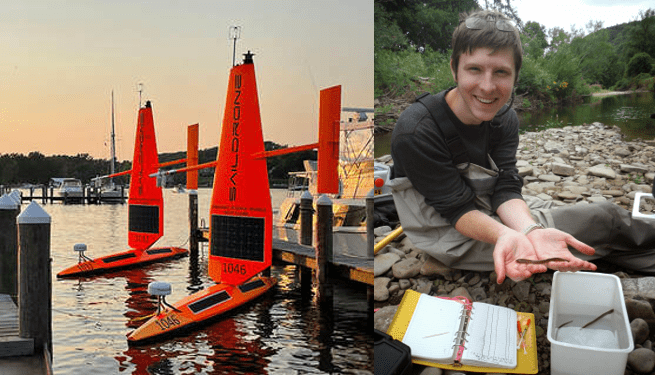 In a jointly led USGS Great Lakes Science Center (Esselman, Warner) – Cornell (Rudstam, Watkins, Sethi) collaboration, we are using saildrones to conduct pelagic fish surveys in Lakes Michigan and Huron. Acoustics surveys have long provided a key tool for surveying schooling fish at large spatial scales; however, persistent questions remain about the behavior of fish near survey ships. Sounding behavior can potentially bias target strengths or push fish to the seafloor acoustic dead zones. Silent, autonomous surface vehicles provide a means of observing fish behavior without the influence of large vessels. By comparing ship- and saildrone-based surveys, we hope to both characterize ship-based acoustics survey biases and also assess the performance of saildrones for large scale acoustic surveys. We are delighted to have Dr. Tom Evans join us as the project postdoc. Prior to joining us at Cornell, Tom was Visiting Assistant Professor at St. Mary’s College. Tom is a fisheries ecologist and earned his PhD at SUNY-ESF studying life history of lamprey eels.
In a jointly led USGS Great Lakes Science Center (Esselman, Warner) – Cornell (Rudstam, Watkins, Sethi) collaboration, we are using saildrones to conduct pelagic fish surveys in Lakes Michigan and Huron. Acoustics surveys have long provided a key tool for surveying schooling fish at large spatial scales; however, persistent questions remain about the behavior of fish near survey ships. Sounding behavior can potentially bias target strengths or push fish to the seafloor acoustic dead zones. Silent, autonomous surface vehicles provide a means of observing fish behavior without the influence of large vessels. By comparing ship- and saildrone-based surveys, we hope to both characterize ship-based acoustics survey biases and also assess the performance of saildrones for large scale acoustic surveys. We are delighted to have Dr. Tom Evans join us as the project postdoc. Prior to joining us at Cornell, Tom was Visiting Assistant Professor at St. Mary’s College. Tom is a fisheries ecologist and earned his PhD at SUNY-ESF studying life history of lamprey eels.
September 14, 2021—Are private investments in nature advancing ocean ecosystem conservation?
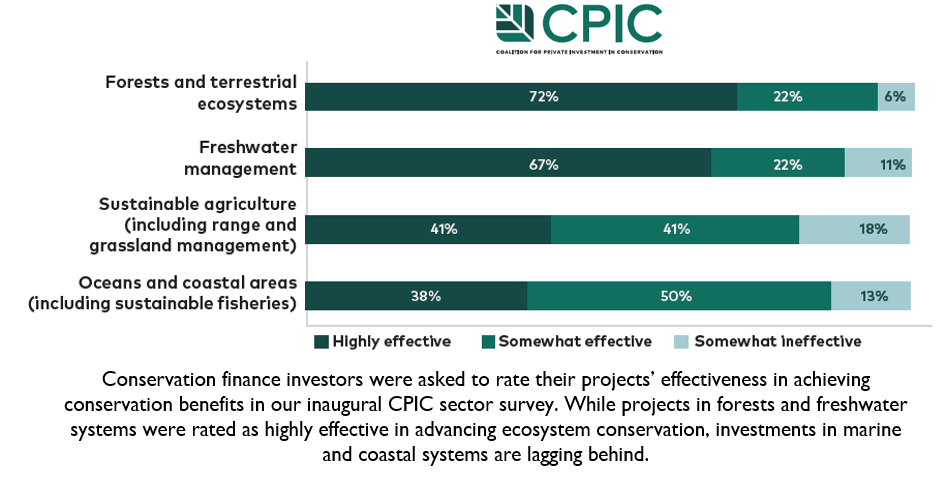 Where do the resources supporting ecosystem assessment and management come from? Currently, most funds derive from government (public) sources, with a smaller amount flowing from philanthropic donors such as conservation-oriented foundations (Deutz et al.). But as human impacts on earth’s ecosystems increase and government and philanthropic budgets stagnate, there is a widening funding gap for global ecosystem conservation. Conservation finance is a small but rapidly growing financial sector seeking to leverage private return-seeking capital to support ecosystem conservation. By developing projects that can generate financial returns while restoring or conserving ecosystem services, so called ‘double bottom line’ private capital investment deals represent the final frontier in filling the global ecosystem conservation funding gap. Activity in this sector is increasing, as demonstrated by a recent sector survey we led through the Coalition for Private Investment in Conservation. The good news is that total private capital invested seeking dual financial + conservation benefits is growing—but in surveying investors about the effectiveness of their projects in advancing ocean and coastal ecosystem conservation, results were mixed with only 1/3 of respondents indicating these deals led to durable conservation outcomes for marine systems. Conservation performance was deemed better in forest and freshwater ecosystems, but there is still significant work to be done to advance the scope and effectiveness of conservation investments in marine ecosystems. Moving forward, we hope increased collaboration across marine scientists and finance practitioners will help overcome these barriers (Fitzgerald et al.). So be bold marine scientists, and talk to your finance and business colleagues to find out how to get involved in advancing investments in marine ecosystems!
Where do the resources supporting ecosystem assessment and management come from? Currently, most funds derive from government (public) sources, with a smaller amount flowing from philanthropic donors such as conservation-oriented foundations (Deutz et al.). But as human impacts on earth’s ecosystems increase and government and philanthropic budgets stagnate, there is a widening funding gap for global ecosystem conservation. Conservation finance is a small but rapidly growing financial sector seeking to leverage private return-seeking capital to support ecosystem conservation. By developing projects that can generate financial returns while restoring or conserving ecosystem services, so called ‘double bottom line’ private capital investment deals represent the final frontier in filling the global ecosystem conservation funding gap. Activity in this sector is increasing, as demonstrated by a recent sector survey we led through the Coalition for Private Investment in Conservation. The good news is that total private capital invested seeking dual financial + conservation benefits is growing—but in surveying investors about the effectiveness of their projects in advancing ocean and coastal ecosystem conservation, results were mixed with only 1/3 of respondents indicating these deals led to durable conservation outcomes for marine systems. Conservation performance was deemed better in forest and freshwater ecosystems, but there is still significant work to be done to advance the scope and effectiveness of conservation investments in marine ecosystems. Moving forward, we hope increased collaboration across marine scientists and finance practitioners will help overcome these barriers (Fitzgerald et al.). So be bold marine scientists, and talk to your finance and business colleagues to find out how to get involved in advancing investments in marine ecosystems!
August 25, 2021—Round goby are in the Hudson River; are they sea bound?
Last month (July 21), our Hudson River Estuaries Program Fisheries Group captured round goby (Neogobius melanostomus) in the Hudson River, the first confirmed evidence of this invading fish in the river. A month later, they have now been detected as far south as Poughkeepsie. This benthic fish enters the food web as both predator on fish eggs, infauna, and Dreissenid mussels, and as a prey item that has been documented in the diets of most piscivorous fish in the Great Lakes basin. Round goby can reach high biomass quickly and thus could become a significant ecosystem component in invaded systems as some of our earlier work has demonstrated (Andres et al. 2020)–former graduate student Matt Paufve took this video from Cayuga Lake illustrating the potential density round goby can reach (here ~70 fish/m2!). Round goby appear to have migrated through the upstate NY canals, and our best guess is that this species moved from Lake Ontario proper to the Hudson River over the past decade since 2011 invasions were first recorded in the Finger Lakes, an average spread rate of about 30 kms/yr. Importantly, round goby can tolerate both fresh and saltwater. This species now theoretically has access to vast swaths of estuarine, marine, and river habitats in the NW Atlantic seaboard if gobies can navigate coastal waters. We will be monitoring round goby closely in the coming years to understand both the ecosystem impact of this adaptable fish in the Hudson River as well as forecast the potential invasion scope for this species as it marches seaward. Video (credit: M. Paufve): imagery from Cayuga Lake, NY, showing a benthos dominated by invasive Dreissenid mussels and round goby, both of which originate from the Ponto-Caspian region of Europe .
August 12, 2021—Larval ecology of native Coregonine fish in the Great Lakes indicates reliance on ice cover duration
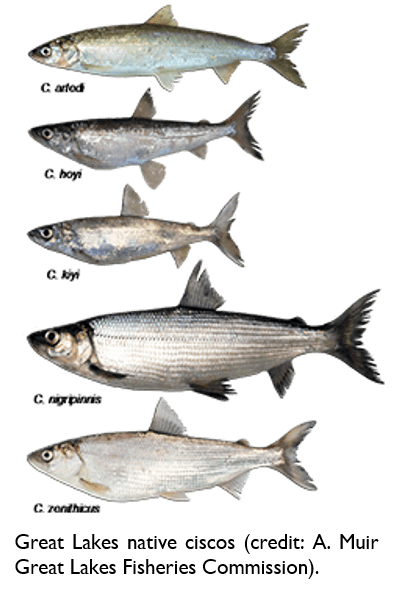 Coregonines such as Lake Whitefish (Coregonus clupeaformis) and Cisco (C. artedi) were once abundant throughout the Great Lakes, underpinning a diverse prey base in the food web and supporting important commercial fisheries. While restoration of coregonine populations is currently a management priority for Great Lakes ecosystems, progress remains slow. One hypothesis for slow population recovery is that poor larval rearing conditions are constraining recruitment and restricting population growth. In a large collaborative effort spanning U.S. and Canadian cooperators, PhD student Taylor Brown recently investigated early life stage habitat use by Lake Whitefish and Cisco across Lake Ontario in a paper published in the Journal of Great Lakes Research. In order to document contemporary spawning activity and to assess the relative importance of regional scale climatic drivers versus local scale habitat characteristics as being associated with coregonine recruitment, we analyzed larval distributions from a spatially extensive data set on 1000+ ichthyoplankton tows mobilized in 2018. Hiearchical GAMM modeling showed that ice duration was a driver of larval distributions in common to both species. In contrast, the Lake Whitefish and Cisco larvae showed habitat niche partitioning based on local site-level habitat morphology. Combined, our results demonstrate strong coregonine recruitment in some historically active locations in Lake Ontario, but the spatial extent of active spawning populations remains restricted. Furthermore, larval distribution results indicate that this nearshore native fish complex may be vulnerable to loss of ice associated with long term climate warming trends across the Great Lakes basin. This work points to a need to understand what role local scale habitat management could play in buffering against recruitment impacts from lake warming to support coregonine population recovery.
Coregonines such as Lake Whitefish (Coregonus clupeaformis) and Cisco (C. artedi) were once abundant throughout the Great Lakes, underpinning a diverse prey base in the food web and supporting important commercial fisheries. While restoration of coregonine populations is currently a management priority for Great Lakes ecosystems, progress remains slow. One hypothesis for slow population recovery is that poor larval rearing conditions are constraining recruitment and restricting population growth. In a large collaborative effort spanning U.S. and Canadian cooperators, PhD student Taylor Brown recently investigated early life stage habitat use by Lake Whitefish and Cisco across Lake Ontario in a paper published in the Journal of Great Lakes Research. In order to document contemporary spawning activity and to assess the relative importance of regional scale climatic drivers versus local scale habitat characteristics as being associated with coregonine recruitment, we analyzed larval distributions from a spatially extensive data set on 1000+ ichthyoplankton tows mobilized in 2018. Hiearchical GAMM modeling showed that ice duration was a driver of larval distributions in common to both species. In contrast, the Lake Whitefish and Cisco larvae showed habitat niche partitioning based on local site-level habitat morphology. Combined, our results demonstrate strong coregonine recruitment in some historically active locations in Lake Ontario, but the spatial extent of active spawning populations remains restricted. Furthermore, larval distribution results indicate that this nearshore native fish complex may be vulnerable to loss of ice associated with long term climate warming trends across the Great Lakes basin. This work points to a need to understand what role local scale habitat management could play in buffering against recruitment impacts from lake warming to support coregonine population recovery.
July 16, 2021—Update: applying the Resist, Accept, or Direct (RAD) framework for ecosystem change
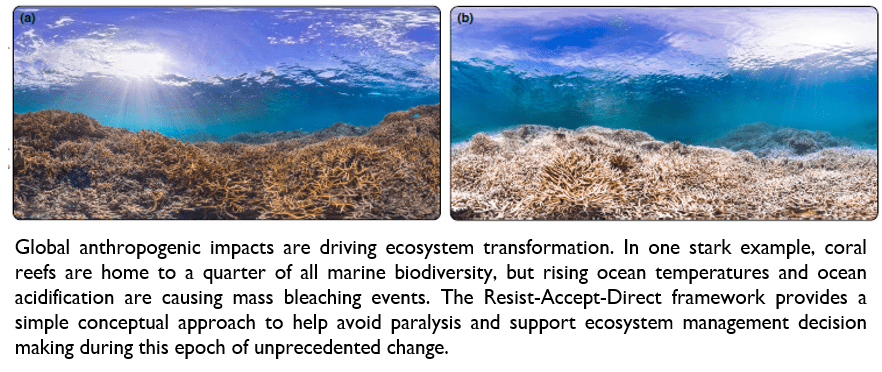 Environmental change is accelerating globally, driving a need for pragmatic approaches to navigate high uncertainty and variability in managing transforming ecosystems. Working with a diverse group of collaborators led by Drs. Abby Lynch and Laura Thompson, we recently published a report in Frontiers in Ecology & the Environment introducing a simple Resist-Accept-Direct conceptual approach to guide ecosystem management. We demonstrate applications of R-A-D strategies through a series of case studies across the U.S. Fish and Wildlife Service National Wildlife Refuges. We hope this approach will provide a practical framework for managers globally as we enter an epoch of unprecedented ecosystem change. The paper is now available online open access, and a great video abstract about the RAD approach created by Abby and Laura is available here.
Environmental change is accelerating globally, driving a need for pragmatic approaches to navigate high uncertainty and variability in managing transforming ecosystems. Working with a diverse group of collaborators led by Drs. Abby Lynch and Laura Thompson, we recently published a report in Frontiers in Ecology & the Environment introducing a simple Resist-Accept-Direct conceptual approach to guide ecosystem management. We demonstrate applications of R-A-D strategies through a series of case studies across the U.S. Fish and Wildlife Service National Wildlife Refuges. We hope this approach will provide a practical framework for managers globally as we enter an epoch of unprecedented ecosystem change. The paper is now available online open access, and a great video abstract about the RAD approach created by Abby and Laura is available here.
July 6, 2021—Three stock assessments in one: joint predatory-prey population estimation supports fisheries management
 Trophic interactions are drivers of ecosystem change and stability, yet are often excluded from fishery assessment models, despite the potential to improve estimates of species dynamics and predictions of future fishery sustainability. Jointly estimated predator-prey stock assessments show promise as models of intermediate complexity to facilitate a transition to ecosystem-based approaches to fisheries management. In a collaboration with the NY Department of Environmental Conservation, Ontario Ministry of Natural Resources, USGS Great Lakes Science Center, and Cornell, PhD student Kimberly Fitzpatrick recently completed our Chinook Salmon – Lake Trout – Alewife multispecies stock assessment to support Lake Ontario fisheries management. Implementing three statistical catch at age stock assessments in one go, we linked predator stocks to the alewife prey base via a bioenergetics model. This multispecies approach provides opportunity to borrow strength across monitoring data sets and provides a framework for managers to forecast both predator- and prey-based scenarios. In the Lake Ontario case, we find that increasing Chinook salmon recruitment along with stable Lake Trout biomass may be leading to an imbalance in prey availability in the lake unless near term alewife recruitment increases. Our results are informing managers’ decisions on future salmon stocking levels to ensure long term sustainability of Lake Ontario fisheries.
Trophic interactions are drivers of ecosystem change and stability, yet are often excluded from fishery assessment models, despite the potential to improve estimates of species dynamics and predictions of future fishery sustainability. Jointly estimated predator-prey stock assessments show promise as models of intermediate complexity to facilitate a transition to ecosystem-based approaches to fisheries management. In a collaboration with the NY Department of Environmental Conservation, Ontario Ministry of Natural Resources, USGS Great Lakes Science Center, and Cornell, PhD student Kimberly Fitzpatrick recently completed our Chinook Salmon – Lake Trout – Alewife multispecies stock assessment to support Lake Ontario fisheries management. Implementing three statistical catch at age stock assessments in one go, we linked predator stocks to the alewife prey base via a bioenergetics model. This multispecies approach provides opportunity to borrow strength across monitoring data sets and provides a framework for managers to forecast both predator- and prey-based scenarios. In the Lake Ontario case, we find that increasing Chinook salmon recruitment along with stable Lake Trout biomass may be leading to an imbalance in prey availability in the lake unless near term alewife recruitment increases. Our results are informing managers’ decisions on future salmon stocking levels to ensure long term sustainability of Lake Ontario fisheries.
June 1, 2021—PhD student Taylor Brown receives an Exemplary Service Award for Graduate Diversity & Inclusion
Congratulations to Taylor Brown who received an ‘Exemplary Service Award‘ from the Cornell Graduate School in recognition of her work toward improving diversity and inclusiveness in the graduate student community. Taylor co-founded the Cornell First Generation and Low-Income Graduate Student Organization, helped found the Diversity Equity & Inclusion Advisory Council in the Department of Natural Resources and the Environment, and is recognized as an active leader in Diversity, Equity, and Inclusion issues within the graduate community on campus. Terrific achievements Taylor!
April 17, 2021—Nutrition consequences of substituting wild capture fisheries for farmed animal alternatives in the Amazon
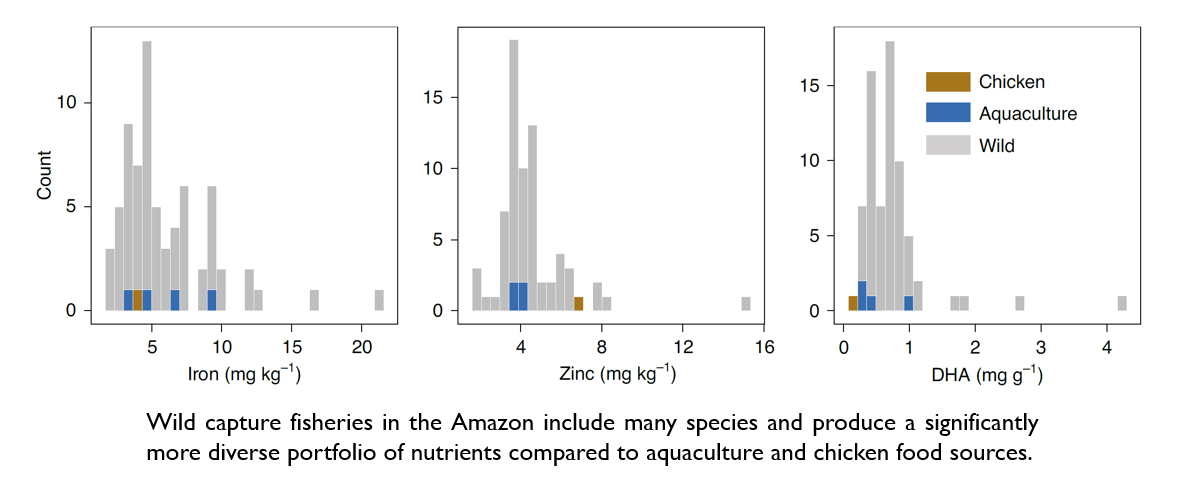 The Amazon is Earth’s largest and most biodiverse river ecosystem. People throughout the Amazon basin benefit from freshwater wild capture fisheries as a food source; however, signs of overexploitation of Amazon fisheries and changing preferences for alternative animal source foods are leading to growing reliance on farmed alternatives to wild fish. In a recent collaboration led by Dr. Sebastian Heilpern, Presidential postdoc fellow at Cornell, we examined the human nutritional consequences of substituting wild fish with farmed fish and chicken alternatives in the Peruvian Amazon. Results show that substituting wild fisheries with chicken and aquaculture has the potential to exacerbate iron deficiencies and limit essential fatty acid availability, although other beneficial nutrients such as zinc and protein remain in plentiful supply with a switch to farmed alternatives. As chicken and aquaculture systems also come with environmental impact tradeoffs, this work highlights the importance of maintaining a diversified food portfolio comprised of both wild capture and sustainably farmed sources as global population continues to increase towards 9.7 billion by 2050. Check out the full paper at Nature Food.
The Amazon is Earth’s largest and most biodiverse river ecosystem. People throughout the Amazon basin benefit from freshwater wild capture fisheries as a food source; however, signs of overexploitation of Amazon fisheries and changing preferences for alternative animal source foods are leading to growing reliance on farmed alternatives to wild fish. In a recent collaboration led by Dr. Sebastian Heilpern, Presidential postdoc fellow at Cornell, we examined the human nutritional consequences of substituting wild fish with farmed fish and chicken alternatives in the Peruvian Amazon. Results show that substituting wild fisheries with chicken and aquaculture has the potential to exacerbate iron deficiencies and limit essential fatty acid availability, although other beneficial nutrients such as zinc and protein remain in plentiful supply with a switch to farmed alternatives. As chicken and aquaculture systems also come with environmental impact tradeoffs, this work highlights the importance of maintaining a diversified food portfolio comprised of both wild capture and sustainably farmed sources as global population continues to increase towards 9.7 billion by 2050. Check out the full paper at Nature Food.
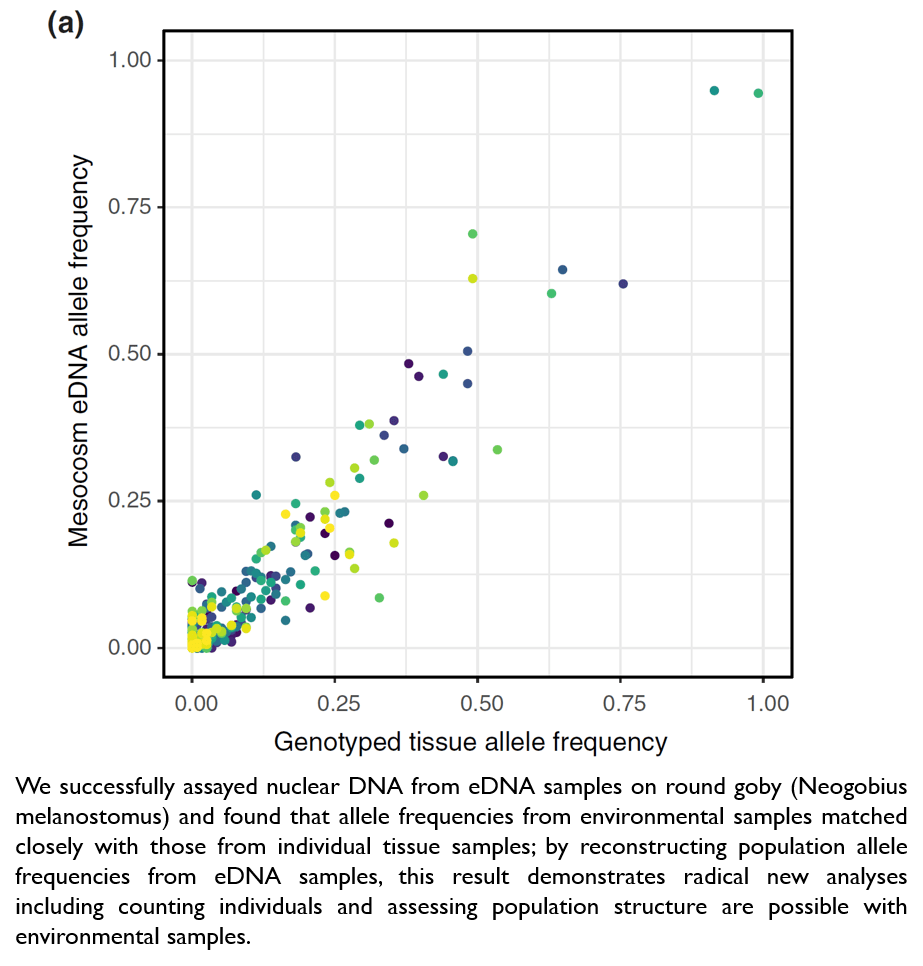 February 26, 2021—Mesocosm experiments demonstrate that population genetics are possible with eDNA
February 26, 2021—Mesocosm experiments demonstrate that population genetics are possible with eDNA
Environmental DNA samples have greatly expanded the tools available for fish and wildlife genetics. But, to date, eDNA applications have been restricted to assessing presence-absence of species. While this is a useful tool for informing species and community ecology, in a novel application, we demonstrate eDNA has much greater potential. We successfully assayed nuclear DNA from environmental samples on round goby, a rapidly expanding invasive fish in N. America, and found that eDNA-based allele frequencies matched closely with those generated from tissues samples on individual fish. This groundbreaking result demonstrates that population genetics applications to assess population structure and wildlife genetics applications to count individuals in time and space with eDNA samples is now possible. Led by PhD student Kara Andres and geneticist Jose Andres at Cornell, our work is now available in a recent paper in Molecular Ecology.
September 17, 2020—Financing nature: we launched an ambitious new report to catalyze resources for global biodiversity conservation
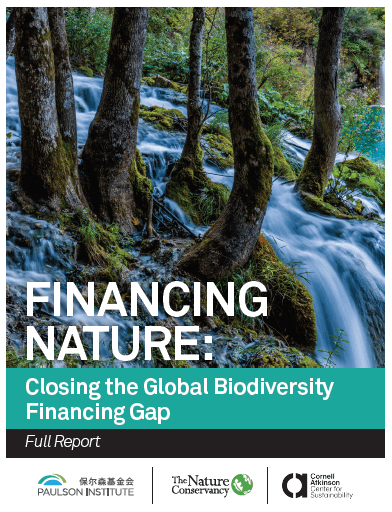 Global biodiversity underpins earth’s natural capital, and thus our societies and economies. Yet, anthropogenic impacts on ecosystems through habitat conversion, invasive species, and climate warming, among other stressors, are accelerating biodiversity loss. How can we reverse this trend? We have the knowledge and tools available to address biodiversity conservation globally, but action requires resources. Management to conserve and restore earth’s biosphere will require a global commitment to adequately finance biodiversity conservation. In a joint collaboration between Cornell Atkinson Center for Sustainability – The Nature Conservancy – The Paulson Institute, we recently launched an ambitious report to quantify current finances devoted to global biodiversity conservation, estimate the future financing needs to adequately support biodiversity conservation, and identify public + private financing flows to address this gap. We estimate that globally we need to mobilize as much as 5-7 times the current spending to adequately support biodiversity conservation. Public finance continues to play a critical role in biodiversity conservation but moving forward private finance and private-public partnerships will be essential for filling the global biodiversity conservation resource gap. Interest in private finance investments with biodiversity positive outcomes is growing, but accelerating the pipeline of deals and ensuring they reach biodiversity goals will require cooperation across both the public and private sectors. We hope this report will help catalyze public and private actors towards collaborative efforts to advance financial resources for biodiversity conservation. Conserving nature is a critical global challenge, and our actions today define the earth we leave to our future generations. Access the full report or the executive summary, and enjoy a short video to inspire you.
Global biodiversity underpins earth’s natural capital, and thus our societies and economies. Yet, anthropogenic impacts on ecosystems through habitat conversion, invasive species, and climate warming, among other stressors, are accelerating biodiversity loss. How can we reverse this trend? We have the knowledge and tools available to address biodiversity conservation globally, but action requires resources. Management to conserve and restore earth’s biosphere will require a global commitment to adequately finance biodiversity conservation. In a joint collaboration between Cornell Atkinson Center for Sustainability – The Nature Conservancy – The Paulson Institute, we recently launched an ambitious report to quantify current finances devoted to global biodiversity conservation, estimate the future financing needs to adequately support biodiversity conservation, and identify public + private financing flows to address this gap. We estimate that globally we need to mobilize as much as 5-7 times the current spending to adequately support biodiversity conservation. Public finance continues to play a critical role in biodiversity conservation but moving forward private finance and private-public partnerships will be essential for filling the global biodiversity conservation resource gap. Interest in private finance investments with biodiversity positive outcomes is growing, but accelerating the pipeline of deals and ensuring they reach biodiversity goals will require cooperation across both the public and private sectors. We hope this report will help catalyze public and private actors towards collaborative efforts to advance financial resources for biodiversity conservation. Conserving nature is a critical global challenge, and our actions today define the earth we leave to our future generations. Access the full report or the executive summary, and enjoy a short video to inspire you.
August 13, 2020—PhD graduate student position in quantitative fisheries ecology
We are seeking a highly motivated student for a fully funded PhD graduate research assistantship in fisheries ecology to investigate mechanisms underlying changing fish community dynamics in temperate lakes. The project is focused on quantitative ecology and will include a rich portfolio of research opportunities spanning population modeling, eDNA validation, and whole-lake food web modeling. See the Opportunities page for more details
August 7, 2020—Responding to ecosystem transformation: Resist, Accept, or Direct change
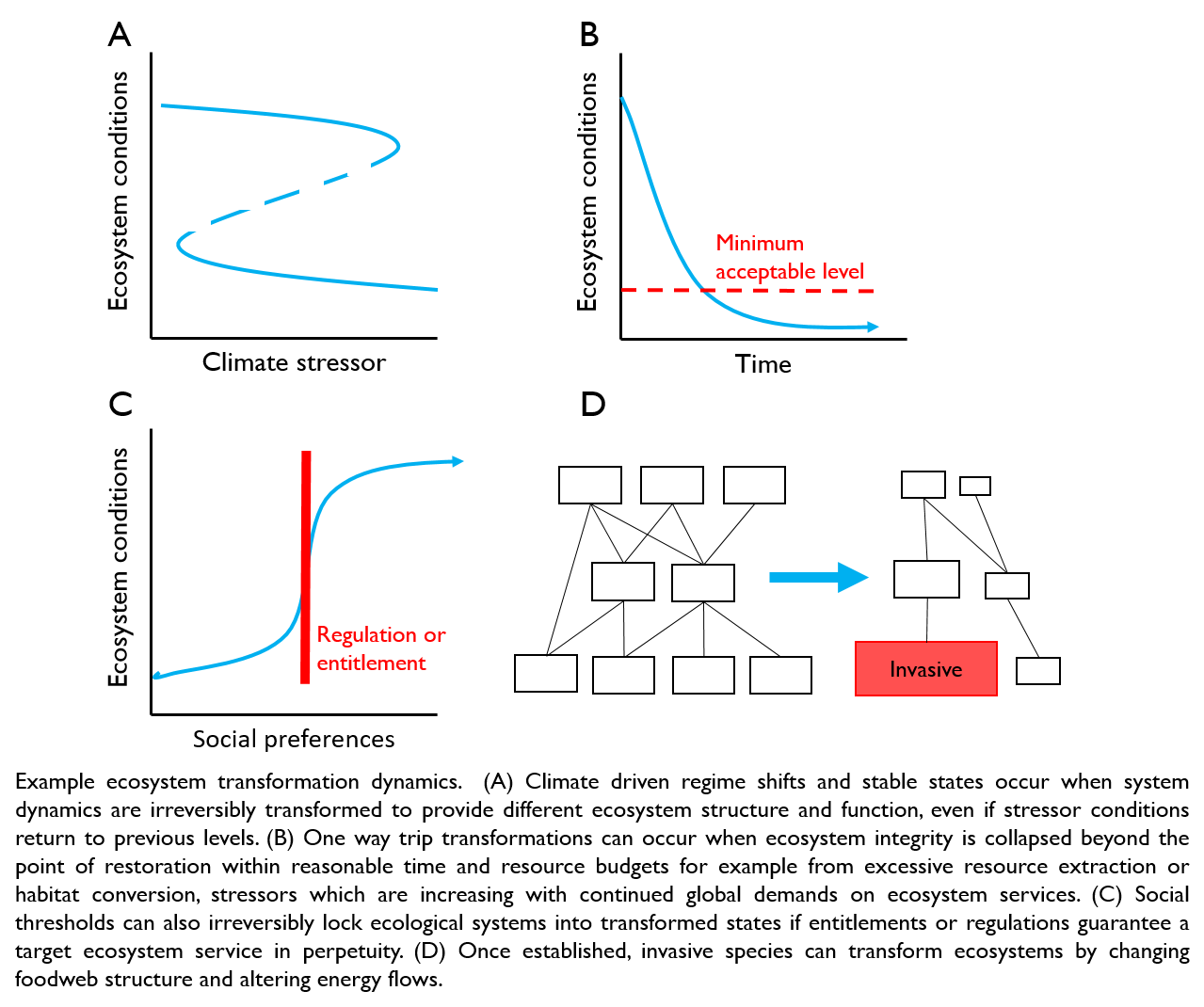 Changes in ecosystem composition, structure, and function are increasing in frequency across the globe in the modern era of human domination of the biosphere. These changes are now manifesting as wholescale ecosystem transformations with greater frequency and extent, presenting significant challenges for managers in responding to rapid system alterations. To raise awareness of the rate of ecosystem change and options to cope with rapid transformations, we launched a joint Wildlife Society – American Fisheries Society working group to synthesize a framework that encompasses three strategies for fish and wildlife managers dealing with ecosystems vulnerable to transformation: managers can resist change and strive to maintain existing ecosystem processes, accept transformation when it is not feasible to resist change or when changes are deemed socially acceptable, or direct change to a future ecosystem configuration that would create desirable outcomes. While this framework is simple, we hope it spurs acknowledgement of the reality of transforming ecosystems for managers and sets a pragmatic path forward. Details of the framework and guiding principles for implementing a R-A-D approach to management under ecosystem transformation will be available in a set of papers led by collaborators Abby Lynch and Laura Thompson at the USGS Climate Adaptation Science Center. The first one coming out in Fisheries magazine is available online now (Thompson et al., 2020).
Changes in ecosystem composition, structure, and function are increasing in frequency across the globe in the modern era of human domination of the biosphere. These changes are now manifesting as wholescale ecosystem transformations with greater frequency and extent, presenting significant challenges for managers in responding to rapid system alterations. To raise awareness of the rate of ecosystem change and options to cope with rapid transformations, we launched a joint Wildlife Society – American Fisheries Society working group to synthesize a framework that encompasses three strategies for fish and wildlife managers dealing with ecosystems vulnerable to transformation: managers can resist change and strive to maintain existing ecosystem processes, accept transformation when it is not feasible to resist change or when changes are deemed socially acceptable, or direct change to a future ecosystem configuration that would create desirable outcomes. While this framework is simple, we hope it spurs acknowledgement of the reality of transforming ecosystems for managers and sets a pragmatic path forward. Details of the framework and guiding principles for implementing a R-A-D approach to management under ecosystem transformation will be available in a set of papers led by collaborators Abby Lynch and Laura Thompson at the USGS Climate Adaptation Science Center. The first one coming out in Fisheries magazine is available online now (Thompson et al., 2020).
July 7, 2020—Close kin mark recapture unlocks novel tools for fisheries assessments
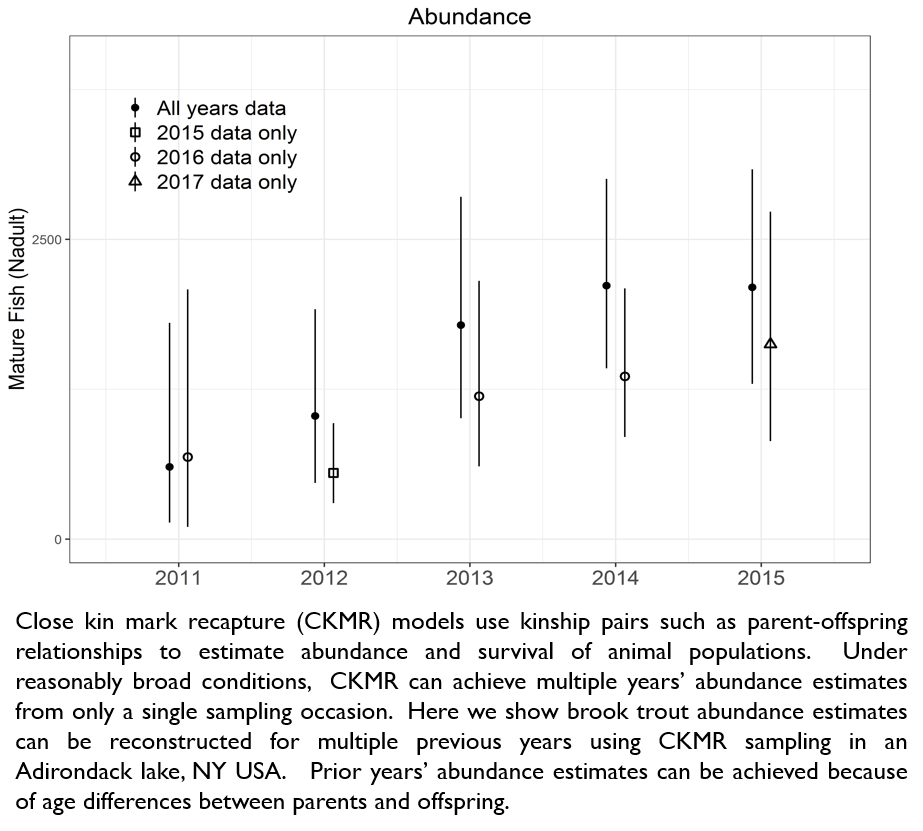 Advances in genetics tools over the past two decades have led to an expansion of mark recapture studies to assess abundance and survival of animal populations at large; however, until recently, genetics have simply been used as a substitute for physical marks. Newly developed ‘close kin’ mark recapture methods represent a step forward in harnessing the power of genetics to expand the tools available for animal population assessment by using kinship assignment tests to identify pairs of related individuals as the recapture event. Recently graduated PhD student in the Department of Natural Resources, Dr. Ben Marcy-Quay, led a paper testing close kin mark recapture for inland fish populations. Our work demonstrated that close kin mark recapture worked well for a salmonid population (brook trout), successfully reproducing abundance and survival estimates that matched closely with proven conventional mark-recapture methods. Importantly, while coming at the cost of additional efforts to run genotypes for sampled individuals, close kin mark recapture demonstrated significant advantages over conventional mark-recapture models, achieving abundance estimates for multiple prior years using data from only a single sampling occasion. With robustness to many forms of capture heterogeneity and the ability to generate population estimates from single sampling occasions, close kin mark recapture shows great promise to expand opportunities for fish population assessments, including using citizen science sampling efforts and combining data from different capture gears commonly encountered during the course of fishery monitoring programs. For more info, check out Ben’s paper in Ecosphere.
Advances in genetics tools over the past two decades have led to an expansion of mark recapture studies to assess abundance and survival of animal populations at large; however, until recently, genetics have simply been used as a substitute for physical marks. Newly developed ‘close kin’ mark recapture methods represent a step forward in harnessing the power of genetics to expand the tools available for animal population assessment by using kinship assignment tests to identify pairs of related individuals as the recapture event. Recently graduated PhD student in the Department of Natural Resources, Dr. Ben Marcy-Quay, led a paper testing close kin mark recapture for inland fish populations. Our work demonstrated that close kin mark recapture worked well for a salmonid population (brook trout), successfully reproducing abundance and survival estimates that matched closely with proven conventional mark-recapture methods. Importantly, while coming at the cost of additional efforts to run genotypes for sampled individuals, close kin mark recapture demonstrated significant advantages over conventional mark-recapture models, achieving abundance estimates for multiple prior years using data from only a single sampling occasion. With robustness to many forms of capture heterogeneity and the ability to generate population estimates from single sampling occasions, close kin mark recapture shows great promise to expand opportunities for fish population assessments, including using citizen science sampling efforts and combining data from different capture gears commonly encountered during the course of fishery monitoring programs. For more info, check out Ben’s paper in Ecosphere.
May 26, 2020—Watershed-scale migration by juvenile fish highlights the importance of lakes for conserving life history diversity of Coho salmon
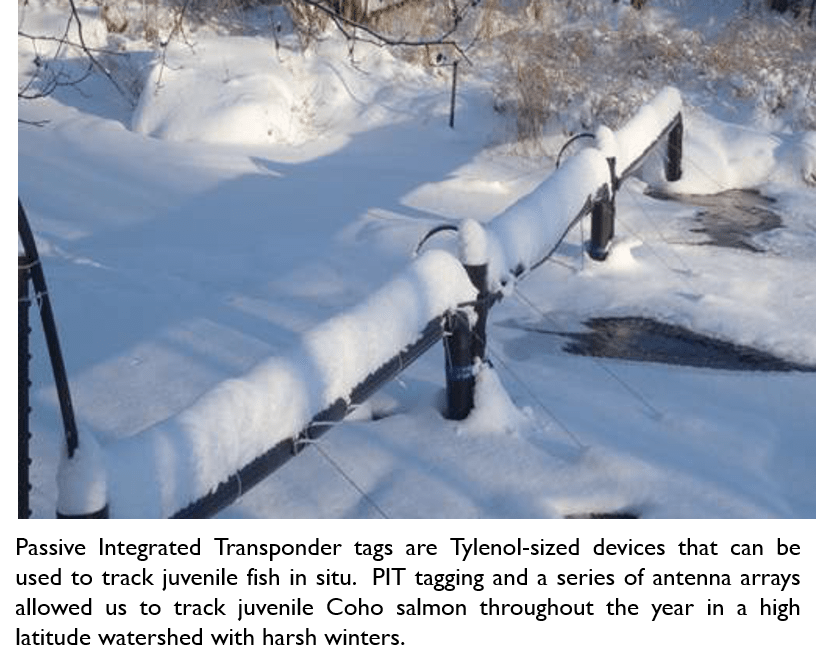 Urbanization and climate-driven hydrological variability present stressors for Pacific salmon during freshwater residency, emphasizing a need to conserve life history diversity for these anadromous species to buffer against ongoing ecosystem changes. To inform watershed management to support life history diversity of Pacific salmon, information on the distribution and movement dynamics of juvenile fish throughout the annual seasonal cycle is needed. While a number of studies have assessed the ecology of juvenile Coho salmon (Oncorhynchus kisucth) during summer and fall seasons, watershed use by this species throughout the annual cycle is less well characterized, particularly in high latitude systems where winter sampling is a challenge. In a collaboration including Alaska Pacific University, the US Fish and Wildlife Service, and Cornell, we recently completed analyzing a large data set on 3,700 tagged juvenile salmon tracked for two complete years in the Big Lake watershed, Alaska. By tracking fish over an entire watershed throughout the year, we were able to provide novel insight into the seasonal life history of Coho salmon. Tagged fish were distributed widely throughout lotic (moving-water) reaches during summer, but then migrate en masse to concentrate in a small subset of lakes for overwintering, emphasizing the importance of maintaining connectivity between lentic and lotic habitats for this species. In fact, the only substantive tributary overwintering observed (8% of tracked fish) was immediately below a culvert and dam blocking access to a sizable lake. These results demonstrate the potential for anthropogenic connectivity blocks to restrict juvenile salmon migration behaviors and potentially constrain life history strategies that rely on movement between lentic and lotic habitats across seasons. Full results are in the paper at Aquatic Conservation.
Urbanization and climate-driven hydrological variability present stressors for Pacific salmon during freshwater residency, emphasizing a need to conserve life history diversity for these anadromous species to buffer against ongoing ecosystem changes. To inform watershed management to support life history diversity of Pacific salmon, information on the distribution and movement dynamics of juvenile fish throughout the annual seasonal cycle is needed. While a number of studies have assessed the ecology of juvenile Coho salmon (Oncorhynchus kisucth) during summer and fall seasons, watershed use by this species throughout the annual cycle is less well characterized, particularly in high latitude systems where winter sampling is a challenge. In a collaboration including Alaska Pacific University, the US Fish and Wildlife Service, and Cornell, we recently completed analyzing a large data set on 3,700 tagged juvenile salmon tracked for two complete years in the Big Lake watershed, Alaska. By tracking fish over an entire watershed throughout the year, we were able to provide novel insight into the seasonal life history of Coho salmon. Tagged fish were distributed widely throughout lotic (moving-water) reaches during summer, but then migrate en masse to concentrate in a small subset of lakes for overwintering, emphasizing the importance of maintaining connectivity between lentic and lotic habitats for this species. In fact, the only substantive tributary overwintering observed (8% of tracked fish) was immediately below a culvert and dam blocking access to a sizable lake. These results demonstrate the potential for anthropogenic connectivity blocks to restrict juvenile salmon migration behaviors and potentially constrain life history strategies that rely on movement between lentic and lotic habitats across seasons. Full results are in the paper at Aquatic Conservation.
February 19, 2020—Join the Cornell Institute of Digital Agriculture 2020 Hackathon
CIDA is hosting it’s annual hackathon February 28 to March 1 on main campus. It’s a great opportunity to work in teams to solve food production sustainability challenges. Participants can join one of 5 challenge areas–this year, Suresh, Neil Mattson (Plant Science), Eugene Won (Animal Science), and Ran Zhao (China Ag University) are hosting the ‘controlled environment agriculture’ challenge. Get out of your comfort zone and join the digital ag hackathon!
February 7, 2020—Cornell School of Continuing Education is hosting a cruise through the inside passage in Alaska this summer
Want to see southeast Alaska by water and learn about the ecosystems firsthand? Suresh will be providing a series of lectures about Alaskan marine and aquatic ecosystems this August as part of the Cornell SCE ‘Education Vacation’ program. More info at SCE and in this little video.
January 27, 2020—Upcoming project on climate ready fishing communities, looking for postdoc

Climate change is advancing rapidly in high latitude oceans leading to shifting marine species distributions, and impacting fish population productivity and variability. As a result, fisheries-reliant communities face increasing threats to local economies and cultural heritage as they bear risk of losing fishing access as marine ecosystems change. We were recently awarded funding in a joint project between Cornell and The Nature Conservancy to assess strategies for “climate ready fishing communities” hosted through the Atkinson Center for a Sustainable Future. Using Alaskan fisheries as a focal system—which combine to >60% of U.S. seafood harvest—we seek to quantify the degree of climate risk facing fishing communities, identify optimal community fishing rights portfolio that are robust to climate-driven fishery changes, and advance efforts to operationalize climate-robust fishing portfolios through innovative finance opportunities to support fishing community climate adaptation strategies. Our project will combine marine ecology, fisheries management, conservation finance, and computer science, representing an exciting opportunity for trans-disciplinary work to address a major ocean sustainability challenge. We are currently seeking a postdoc for the project, advertisement available here.
December 13, 2019—Combining fisheries surveys to inform marine species distributions at ecologically relevant scales
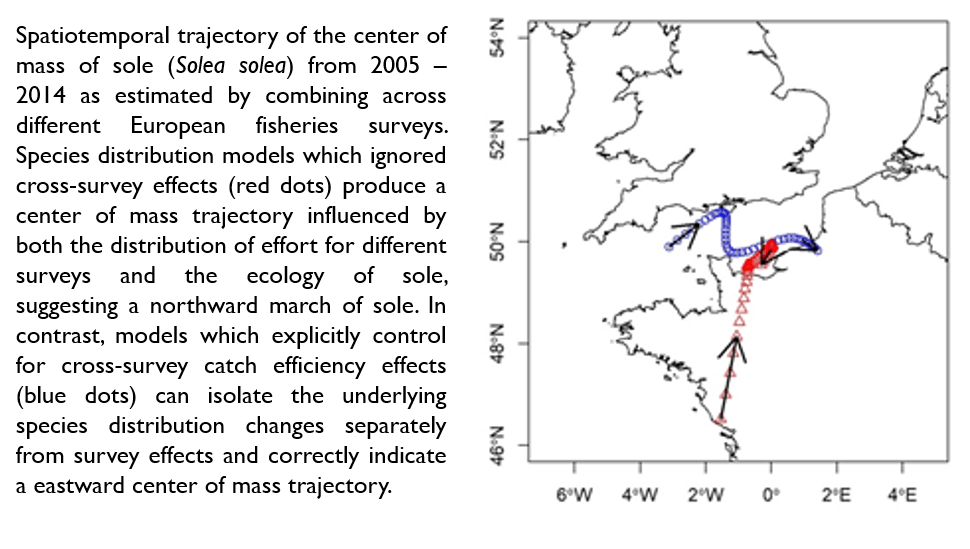 Marine species’ ranges are extensive, typically spanning across fisheries jurisdictional boundaries. Thus a common challenge in fisheries assessments is making inference about fish populations from multiple different surveys. Visiting fulbright scholar, Meadhbh Moriarty from Dr. Chris McGonigle’s lab at Ulster University recently completed a seascape-scale analysis to examine whether consistent species distribution information can be garnered by combining disparate fishery surveys. In a paper in press at ICES Journal of Marine Science, she assembled 19 European trawl surveys for 254 different species-length combinations and used GAMMs to assess the relative importance of variables related to species distribution versus those related to differences in survey catch efficiency. Results demonstrated that valid species distribution inference could be achieved by combining data across fisheries surveys for most species, which is good news for assessing marine species at ecologically relevant (versus politically constrained) scales. However, inference about some species’ distributions appeared to be strongly influenced by combining across surveys, with no clear pattern associated with taxa functional form. This highlights the importance of modelling approaches that can control for gear differences as a precautionary measure when combining surveys.
Marine species’ ranges are extensive, typically spanning across fisheries jurisdictional boundaries. Thus a common challenge in fisheries assessments is making inference about fish populations from multiple different surveys. Visiting fulbright scholar, Meadhbh Moriarty from Dr. Chris McGonigle’s lab at Ulster University recently completed a seascape-scale analysis to examine whether consistent species distribution information can be garnered by combining disparate fishery surveys. In a paper in press at ICES Journal of Marine Science, she assembled 19 European trawl surveys for 254 different species-length combinations and used GAMMs to assess the relative importance of variables related to species distribution versus those related to differences in survey catch efficiency. Results demonstrated that valid species distribution inference could be achieved by combining data across fisheries surveys for most species, which is good news for assessing marine species at ecologically relevant (versus politically constrained) scales. However, inference about some species’ distributions appeared to be strongly influenced by combining across surveys, with no clear pattern associated with taxa functional form. This highlights the importance of modelling approaches that can control for gear differences as a precautionary measure when combining surveys.
November 19, 2019—Launch of the Research Working Group @ the Coalition for Private Investment in Conservation
 Suresh joined a newly launched Research Working Group at the Coalition for Private Investment in Conservation. The group is made up of experts in conservation science and finance, with participants spanning academic institutions, finance practitioners, and conservation organizations. The working group had its inaugural meeting held at Cornell last week. Moving forward, the Research Working Group seeks to identify key knowledge needs to address obstacles to greater private investment in ecosystem conservation.
Suresh joined a newly launched Research Working Group at the Coalition for Private Investment in Conservation. The group is made up of experts in conservation science and finance, with participants spanning academic institutions, finance practitioners, and conservation organizations. The working group had its inaugural meeting held at Cornell last week. Moving forward, the Research Working Group seeks to identify key knowledge needs to address obstacles to greater private investment in ecosystem conservation.
November 12, 2019—Walruses are spread across a vast expanse of sea but maintain one genetic population
 Pacific Walruses (Odobenus rosmarus divergens) range throughout the Bering and Chukchi Sea, migrating thousands of kms annually. The animals rely heavily on the advancing and retreating sea ice as a resting and foraging platform. As the extent and timing of sea ice continues to change under global climate warming, Walruses are faced with greater geographic isolation and a shift to more shore-oriented life history. Thus, impacts of sea ice loss are a key concern for the long term status of this species. With such a large geographic range, it is possible genetically distinct subpopulations have developed over time, presenting questions about whether some subpopulations, and thus genetic diversity, may be at greater risk of impacts from sea ice loss. In a project led by Dr. Bill Beatty and the Conservation Genetics Lab at the US Fish and Wildlife Service in Alaska, we recently completed analysis investigating whether Pacific Walruses exhibit genetic population structure. Using samples collected during a massive seascape-scale collaborative sampling effort from 2013-2017, we genotyped over 8000 walruses and found no evidence supporting genetic structure across the species. This indicates that this gregarious social animal has maintained a panmictic population across its vast geographic range; however, as sea ice dynamics continue to change, Walrus migration behavior will shift shoreward, potentially altering the social structure and thus the evolutionary forces maintaining panmixia in this arctic sea mammal.
Pacific Walruses (Odobenus rosmarus divergens) range throughout the Bering and Chukchi Sea, migrating thousands of kms annually. The animals rely heavily on the advancing and retreating sea ice as a resting and foraging platform. As the extent and timing of sea ice continues to change under global climate warming, Walruses are faced with greater geographic isolation and a shift to more shore-oriented life history. Thus, impacts of sea ice loss are a key concern for the long term status of this species. With such a large geographic range, it is possible genetically distinct subpopulations have developed over time, presenting questions about whether some subpopulations, and thus genetic diversity, may be at greater risk of impacts from sea ice loss. In a project led by Dr. Bill Beatty and the Conservation Genetics Lab at the US Fish and Wildlife Service in Alaska, we recently completed analysis investigating whether Pacific Walruses exhibit genetic population structure. Using samples collected during a massive seascape-scale collaborative sampling effort from 2013-2017, we genotyped over 8000 walruses and found no evidence supporting genetic structure across the species. This indicates that this gregarious social animal has maintained a panmictic population across its vast geographic range; however, as sea ice dynamics continue to change, Walrus migration behavior will shift shoreward, potentially altering the social structure and thus the evolutionary forces maintaining panmixia in this arctic sea mammal.
September 25, 2019—North Pacific Research Board Science Panel
 Suresh was recently appointed to the North Pacific Research Board Science Panel. The NPRB supports research for ecosystem management in the Arctic, Bering Sea, and Gulf of Alaska waters around Alaska. The organization has played a key role in supporting science, outreach, and education in the region since 1997. Science Panel members provide strategic and technical assistance to the NPRB and serve four year terms.
Suresh was recently appointed to the North Pacific Research Board Science Panel. The NPRB supports research for ecosystem management in the Arctic, Bering Sea, and Gulf of Alaska waters around Alaska. The organization has played a key role in supporting science, outreach, and education in the region since 1997. Science Panel members provide strategic and technical assistance to the NPRB and serve four year terms.
September 20, 2019—Is hydropower a green energy option? Location, location, location.
 Over 351 large hydropower dams have been proposed for development in the Amazon, a global freshwater biodiversity hotspot. Dams impact aquatic ecosystems by blocking the flow of rivers, altering physical, biogeochimcal, and ecological processes, and thus sustainable hydropower development will require consideration of a suite of important benefits and disadvantages. While hydropower can be a source of low-emissions energy, this is not always the case. We recently published an analysis led by Atkinson Center Postdoctoral Fellow Rafael Almeida and Cornell professors Alex Flecker and Carla Gomes that found hydropower dams vary widely in their greenhouse gas (GHG) emissions. Dams with large reservoirs release significant amounts of methane, and these projects tend to be at low elevations where rivers have lower gradients and require water storage to produce energy. Using cutting edge computational approaches applied to river networks, we find that optimal dam planning for proposed energy expansion in the Amazon that identifies low-emissions dam portfolios can dramatically improve aggregate hydropower emissions performance and meet UN 2030 Agenda green energy goals. In contrast, ad hoc planning can lead to significant carbon emissions, where some dams would produce GHG emission at rates equivalent to gas and coal-fired plants. Thus, the fate of hydropower as a low-GHG energy portfolio to satisfy S. American electricity needs rests critically on strategic planning at basin-wide scales. The paper is available at Nature Communications.
Over 351 large hydropower dams have been proposed for development in the Amazon, a global freshwater biodiversity hotspot. Dams impact aquatic ecosystems by blocking the flow of rivers, altering physical, biogeochimcal, and ecological processes, and thus sustainable hydropower development will require consideration of a suite of important benefits and disadvantages. While hydropower can be a source of low-emissions energy, this is not always the case. We recently published an analysis led by Atkinson Center Postdoctoral Fellow Rafael Almeida and Cornell professors Alex Flecker and Carla Gomes that found hydropower dams vary widely in their greenhouse gas (GHG) emissions. Dams with large reservoirs release significant amounts of methane, and these projects tend to be at low elevations where rivers have lower gradients and require water storage to produce energy. Using cutting edge computational approaches applied to river networks, we find that optimal dam planning for proposed energy expansion in the Amazon that identifies low-emissions dam portfolios can dramatically improve aggregate hydropower emissions performance and meet UN 2030 Agenda green energy goals. In contrast, ad hoc planning can lead to significant carbon emissions, where some dams would produce GHG emission at rates equivalent to gas and coal-fired plants. Thus, the fate of hydropower as a low-GHG energy portfolio to satisfy S. American electricity needs rests critically on strategic planning at basin-wide scales. The paper is available at Nature Communications.
Aug 20, 2019—Alternative income generating activities to fishing in tropical communities
 Widespread overharvest and overcapacity have led to rapidly declining fishery catches and marine ecosystem degradation in many tropical communities. To allow stocks to recover and transition towards sustainable fishing, reducing fishing effort remains a grand challenge in ocean sustainability. The development of Alternative Income Generating Activities represents an important strategy for reducing the economic reliance of coastal communities on fishing, and potentially reducing pressure on wild stocks. Marine ecotourism derives non-extractive benefits from the same natural capital supporting fisheries, and thus has potential as a complementary or alternative income generating activity to fishing. In collaboration with Environmental Defense Fund and the Atkinson Center, we recently assessed the conditions under which marine ecotourism can enable alternative income generating activities to fishing in Moalboal, Philippines, a coastal tropical community in the Coral Triangle. Importantly, while marine ecotourism typically centers around large animals like sharks and rays, a combination of nearshore coral reefs and a dense school of herrings provide a large tourism draw in this community. We estimate that marine ecotourism generates an estimated 17+ million USD in revenues annually to the Moalboal community annually, supporting employment opportunities for ~1,000 community members, including fishers. In contrast, we estimate the extractive value of the herring shoal would be 100 times smaller (0.033 – 0.115 million USD) than the flow of benefits supported through marine ecotourism related to these fish. From the Moalboal experience, we find a key set of enabling conditions support marine ecotourism as a potential livelihood diversification or alternative to extractive fishing. Full results are available in a paper in Biological Conservation. And big thanks to the community of Moalboal for working with us!
Widespread overharvest and overcapacity have led to rapidly declining fishery catches and marine ecosystem degradation in many tropical communities. To allow stocks to recover and transition towards sustainable fishing, reducing fishing effort remains a grand challenge in ocean sustainability. The development of Alternative Income Generating Activities represents an important strategy for reducing the economic reliance of coastal communities on fishing, and potentially reducing pressure on wild stocks. Marine ecotourism derives non-extractive benefits from the same natural capital supporting fisheries, and thus has potential as a complementary or alternative income generating activity to fishing. In collaboration with Environmental Defense Fund and the Atkinson Center, we recently assessed the conditions under which marine ecotourism can enable alternative income generating activities to fishing in Moalboal, Philippines, a coastal tropical community in the Coral Triangle. Importantly, while marine ecotourism typically centers around large animals like sharks and rays, a combination of nearshore coral reefs and a dense school of herrings provide a large tourism draw in this community. We estimate that marine ecotourism generates an estimated 17+ million USD in revenues annually to the Moalboal community annually, supporting employment opportunities for ~1,000 community members, including fishers. In contrast, we estimate the extractive value of the herring shoal would be 100 times smaller (0.033 – 0.115 million USD) than the flow of benefits supported through marine ecotourism related to these fish. From the Moalboal experience, we find a key set of enabling conditions support marine ecotourism as a potential livelihood diversification or alternative to extractive fishing. Full results are available in a paper in Biological Conservation. And big thanks to the community of Moalboal for working with us!
May 27, 2019—Estimating survival of fish at large in the sea with pop-up tags
 Fish survival is a fundamental demographic process that can inform fisheries ecology and management—but the ocean is a big place and observing fish survival for marine species is difficult. Previous efforts often relied on marking fish with tags, releasing them, and then re-capturing marked individuals; a costly and labor-intensive approach with high risk of failure if insufficient recaptures are achieved. Recent advances in applications of archival tags (see this work by collaborator Dr. Julie Nielsen) provide a new approach to this problem, providing ability to track the fate of individual fish through continuous data recording. In a recently completed study in collaboration with FishNext research (Dr. Craig Rose), U of AK, Alaska Pacific University, the Halibut Commission, and Bering Sea fishing operators, we fitted Pacific halibut with archival satellite tags with onboard accelerometers. Tags recorded summaries of fish movements (accelerations) and transmitted data via satellite after a 60-day programmed release. By examining time series of fish movement, we could monitor survival—basically, flatlines indicate mortality events. Our results published in CJFAS provide first ever direct assessment of survival for halibut at large in the ocean and are providing information to inform discard management for Bering Sea fisheries. This novel use of tag acceleration data has promise to advance survival modeling for marine species regardless of the spatial extent of their movement range.
Fish survival is a fundamental demographic process that can inform fisheries ecology and management—but the ocean is a big place and observing fish survival for marine species is difficult. Previous efforts often relied on marking fish with tags, releasing them, and then re-capturing marked individuals; a costly and labor-intensive approach with high risk of failure if insufficient recaptures are achieved. Recent advances in applications of archival tags (see this work by collaborator Dr. Julie Nielsen) provide a new approach to this problem, providing ability to track the fate of individual fish through continuous data recording. In a recently completed study in collaboration with FishNext research (Dr. Craig Rose), U of AK, Alaska Pacific University, the Halibut Commission, and Bering Sea fishing operators, we fitted Pacific halibut with archival satellite tags with onboard accelerometers. Tags recorded summaries of fish movements (accelerations) and transmitted data via satellite after a 60-day programmed release. By examining time series of fish movement, we could monitor survival—basically, flatlines indicate mortality events. Our results published in CJFAS provide first ever direct assessment of survival for halibut at large in the ocean and are providing information to inform discard management for Bering Sea fisheries. This novel use of tag acceleration data has promise to advance survival modeling for marine species regardless of the spatial extent of their movement range.
April 1, 2019— Seascape scale benthic habitat disturbance modeling

Twenty percent of global wild capture seafood production—32 million metric tons per year—is harvested using bottom-tendered fishing gear such as trawl and dredge with potential to impact seafloor ecosystems. Presently, spatial closures (marine reserves) which prohibit fishing are the dominant policy tool used to manage seafloor impact; however, fishing gear modifications to reduce bottom contact may provide a biologically and economically sustainable alternative. In collaboration with fishery managers and fishing stakeholders, we have been implementing a suite of efforts to develop seafloor impact modeling tools and utilize these advances to assess relative tradeoffs in implementing spatial closures versus fishing gear modifications to reduce seafloor contact. PhD student Scott Smeltz recently published the ‘Fishing Effects’ modelling framework in CJFAS. This spatially explicit model captures the impact and recovery dynamics of commercial fishing impacts on benthic ecosystems, and is already being utilized by the North Pacific Fishery Management Council to evaluate long-term impacts to the seafloor from fishing. Next up we are working on implementing the framework for other U.S. fishery management councils, and are looking towards global fishery impact analyses. Stay tuned!
January 17, 2019—Taking advantage of industrial monitoring to inform the ecology of threatened Beluga whales

Cook Inlet in Alaska is home to a unique population of Beluga whales (Delphinapterus leucas). Beluga populations in the inlet continue to decline, prompting their listing as endangered under the U.S. Endangered Species Act. Presently, oil and gas exploration, shipping, and commercial fishing, all occur in Cook Inlet, and there is concern about the overlap between anthropogenic activities and Beluga whales. As migrating diving whales, Belugas are difficult to observe. In a recently complete project, we worked with energy production firms to make use of required industrial monitoring aerial surveys to assess the spatial ecology of Belugas in Cook Inlet. While industrial monitoring data is not perfect, for example lacking corrections for whale detection, these surveys occur at high temporal and spatial frequency. In fact, over a 2 year study period, we benefited from 109 aerial survey days carried out by a single energy firm. With high frequency coverage, industrial monitoring data showed clear seasonal distributions of whales following a sequential portfolio of target prey fields. This suggests potential for separating anthropogenic activities over both space and time to minimize overlap with whale activities. Moving forward, partnering with industrial monitoring programs which are mandated by federal regulations may provide a useful auxillary data stream to augment scientific surveys in assessing marine mammal ecology. A paper on the project is available in Wildlife Society Bulletin, and also highlighted in a science news piece from The Wildlife Society here.
October 17, 2018—Conservation aquaculture: restoring native fish diversity in New York
 Lakes across North America are experiencing a suite of landscape stressors including climate change, invasive species introductions, and changes in nutrient inputs. In the Finger Lakes region of NY, we are exploring opportunities to restore native fish diversity as a means to improve lake resilience to these stressors. In one example, we are part of a large effort to re-introduce extirpated Cisco, Coregonus artedi, in the Finger Lakes region. Working with the NY Department of Environmental Conservation and the USGS Tunison Aquatic Labs, we released some 75000 juvenile Cisco to Keuka Lake today [see video below–fish immediately sound upon release]. This is the first of a series of annual releases planned to re-establish this native forage fish in the area. To understand how the fish survive in their new environment, we are utilizing new acoustic tag technology which is now miniaturized sufficiently to allow for tag deployments in small fish. Over the next six months, we’ll monitor the movement and survival of Cisco, providing key information needed to guide conservation aquaculture practices for Coregonine restoration in the great Finger Lakes and Great Lakes region.
Lakes across North America are experiencing a suite of landscape stressors including climate change, invasive species introductions, and changes in nutrient inputs. In the Finger Lakes region of NY, we are exploring opportunities to restore native fish diversity as a means to improve lake resilience to these stressors. In one example, we are part of a large effort to re-introduce extirpated Cisco, Coregonus artedi, in the Finger Lakes region. Working with the NY Department of Environmental Conservation and the USGS Tunison Aquatic Labs, we released some 75000 juvenile Cisco to Keuka Lake today [see video below–fish immediately sound upon release]. This is the first of a series of annual releases planned to re-establish this native forage fish in the area. To understand how the fish survive in their new environment, we are utilizing new acoustic tag technology which is now miniaturized sufficiently to allow for tag deployments in small fish. Over the next six months, we’ll monitor the movement and survival of Cisco, providing key information needed to guide conservation aquaculture practices for Coregonine restoration in the great Finger Lakes and Great Lakes region.
August 30, 2018— Supporting tropical fisheries management with tech
 Fish play a central role in the culture and food supply of the ocean nation of the Philippines, yet these fisheries involve many thousands of harvesters spread out over an archipelago of 7,000 islands. Fisheries management in this context is difficult and data limited, but new technologies and a commitment to science-based regulations can improve the long term sustainability of these incredible ocean resources. In a collaboration between Cornell, the Environmental Defense Fund, and SUNY-Stony Brook funded by the Atkinson Center for a Sustainable Future, we are investigating passive and active acoustics tools to support Philippines fisheries management. Working with our colleagues at the Bureau of Fish and Aquatic Resources, this summer we conducted pilot sampling to assess stocks of small pelagic fish in the Visayan Sea. Active acoustic sampling led by Dr. Joe Warren (Stony Brook) has demonstrated positive initial results where we were able to assess dense sardine shoals in a marine reserve in Moalboal. In another fishing site at Estancia Bay, we found Fish Aggregating Devices (FADs) were dense enough to change the distribution of small pelagics into a point-based grid. In the coming months, we will be exploring the feasibility of passive acoustic sound recordings to augment fisheries assessments. Ultimately, we hope to cooperate with BFAR to design and implement an acoustics-based assessment program to support sustainable fisheries management in the Philippines.
Fish play a central role in the culture and food supply of the ocean nation of the Philippines, yet these fisheries involve many thousands of harvesters spread out over an archipelago of 7,000 islands. Fisheries management in this context is difficult and data limited, but new technologies and a commitment to science-based regulations can improve the long term sustainability of these incredible ocean resources. In a collaboration between Cornell, the Environmental Defense Fund, and SUNY-Stony Brook funded by the Atkinson Center for a Sustainable Future, we are investigating passive and active acoustics tools to support Philippines fisheries management. Working with our colleagues at the Bureau of Fish and Aquatic Resources, this summer we conducted pilot sampling to assess stocks of small pelagic fish in the Visayan Sea. Active acoustic sampling led by Dr. Joe Warren (Stony Brook) has demonstrated positive initial results where we were able to assess dense sardine shoals in a marine reserve in Moalboal. In another fishing site at Estancia Bay, we found Fish Aggregating Devices (FADs) were dense enough to change the distribution of small pelagics into a point-based grid. In the coming months, we will be exploring the feasibility of passive acoustic sound recordings to augment fisheries assessments. Ultimately, we hope to cooperate with BFAR to design and implement an acoustics-based assessment program to support sustainable fisheries management in the Philippines.
July 24, 2018— Can we count individuals with eDNA?
While genetic material derives from individuals, mixtures of DNA from multiple contributors abound in the environment. We have been leading work to extend a statistical model from criminal forensics that can be used to estimate the number of individuals within a DNA mixture sample. See our recent paper in Methods in Ecology and Evolution here. If reliable genotypes for DNA mixtures can be obtained, our work indicates the estimates of the number of contributing individuals can be achieved across a range of scenarios, potentially providing new opportunities to use genetics to inform ecology. In one pilot study, we used our DNA mixture model to estimate the number of yellow perch prey in largemouth bass stomachs and compared this to traditional visual-assessment based counting of prey items. DNA mixture analysis, which doesn’t require visual identification of diet items, estimated perch predation rates that were 5-fold higher than the traditional visual diet assessment method which can miss-identify partially digested items. Presently, we are exploring the feasibility of counting individuals from eDNA samples which can contain genetic material from multiple specimens. This would expand the tools available for eDNA work, moving beyond presence/absence analysis to inform count-based ecological inference.
May 30, 2018— Separating capture versus tagging related impacts on salmon by observing the unobservable
 A key goal of fish tagging is to provide information on the ecology of fish at large. For salmon, radio tags have proved useful for understanding migration and spawning behavior. But tagging studies require a strong assumption that tagged fish behave as unhandled fish. We recently completed a project to examine whether esophageally implanted radio tags impacted salmon migration behavior. Importantly, we used a novel statistical model to fit arrival curves to salmon run information (Sethi and Bradley 2016) to estimate migration behavior for fish never captured and handled for tagging. By fitting run curves to indices of fish arrival, we can compare reference dates at two sites along a migration route to get an estimate of travel times for fish never directly handled. This provides valuable information to separate capture versus tag-related impacts to salmon freshwater migrations. In fact we found evidence that radio tags had negligible impact on chum salmon migration performance once deployed, but that gillnet-based capture itself may be implicated with migration delays. Results are being published in Fisheries Management and Ecology.
A key goal of fish tagging is to provide information on the ecology of fish at large. For salmon, radio tags have proved useful for understanding migration and spawning behavior. But tagging studies require a strong assumption that tagged fish behave as unhandled fish. We recently completed a project to examine whether esophageally implanted radio tags impacted salmon migration behavior. Importantly, we used a novel statistical model to fit arrival curves to salmon run information (Sethi and Bradley 2016) to estimate migration behavior for fish never captured and handled for tagging. By fitting run curves to indices of fish arrival, we can compare reference dates at two sites along a migration route to get an estimate of travel times for fish never directly handled. This provides valuable information to separate capture versus tag-related impacts to salmon freshwater migrations. In fact we found evidence that radio tags had negligible impact on chum salmon migration performance once deployed, but that gillnet-based capture itself may be implicated with migration delays. Results are being published in Fisheries Management and Ecology.
May 1, 2018— Coping with extreme climate: ecosystem service modeling for conservation planning in African freshwater systems
Teaming up with the Nature Conservancy’s Africa program, we were fortunate to join a collaboration under the NatureNet Fellows program to support postdoctoral research on climate adaptation strategies for freshwater ecosystem service management in the African Great Lakes. As a postdoctoral NatureNet Fellow at Cornell, Diana Rypkema is leading a project to explore ecosystem service risk management strategies in the face of press and pulse climate stress. Combining fisheries and aquaculture planning with climate projection data, the project will explore opportunities to proactively buffer against climate shocks in maintaining freshwater ecosystem service portfolios. Diana will be collaborating with our group and Dr. Pat Sullivan at Cornell, and will work closely with Dr. Tracy Baker at the Nature Conservancy to conduct this exciting work. Congratulations Diana!
December 1, 2017—Characterizing the realized niche of invasive round goby in inland lakes
As art of a graduate seminar led by Suresh, Jesse Lepak, and Aaron Rice (NTRES 6940 Advanced fisheries research methods), we’re analyzing a benthic videography survey from deep Cayuga Lake to characterize the distribution of invasive round goby (Neogobius melanostomus). Round goby came to the Great Lakes basin from the Caspian Black Seas as stowaways in cargo ship ballast water. Since their detection in the Great Lakes in the early 1990s, they’ve been rapidly expanding inland in North America. Round goby can quickly reach high abundances—70+ fish/m2 in Cayuga Lake (Finger Lakes, NY) less than a decade after their introduction. There are a number of open questions about how large of a trophic impact this introduced fish may have on invaded inland lakes. To address that, we are investigating the habitat use of round goby in the Finger Lakes region of NY on the southern edge of the invasion front. Our preliminary analysis indicates that while goby can reach high densities, it appears they have a very narrow realized niche during the summer/fall part of the year in deep lakes (Figure below). Round goby in Cayuga Lake were found in a small temperature and depth band. This indicates that goby habitat utilization in deeper lakes may be restricted to the nearshore littoral zone, whereas they may have much wider distribution and potential for impact in shallow inland lakes. We’re continuing to analyze data and will also be conducting a winter survey early next year. Great job NTRES 6940 students!

Sept 28, 2017—High value of ecological information for river restoration
After a couple centuries of chopping up freshwater watersheds with dams and culverts, fish passage connectivity restoration has become a top priority in river ecosystem management. But dam and culvert mitigation is expensive. This has led to some recent advances in optimal fish passage restoration. Working with the U.S. Fish and Wildlife Service in Alaska and computer scientist Dr. Jesse O’Hanley, we recently completed a 5 year project integrating Pacific salmon ecology directly into optimal fish passage restoration decisions. Our work demonstrated high value of ecological information for river restoration in terms of gains in planning efficiency. For our study watershed in Alaska, the ecologically informed restoration planning approach could achieve the same amount of restoration benefit as planning solutions based solely on the physical stream network but with 16-28% less cost. Investing in ecological studies may achieve win–win outcomes of improved understanding of aquatic ecology and greater watershed restoration efficiency. Additional details on the approach can be found in our recent Landscape Ecology article.
June 26, 2017—Rapid response to invasive plants in the Arctic
The remoteness of arctic ecosystems no longer protects against invasive species introductions. Rather, the mix of urban hubs surrounded by undeveloped expanses creates a ratchet process where human activity can introduce and spread invaders, but for which the costs of monitoring and managing remote ecosystems is prohibitive. We recently published a paper in Biological Conservation examining the use of herbicides as a rapid response tool to nip invasive water plants in the bud. In a large multi-lake experiment involving collaborators from Cornell University, Alaska Pacific University, Kenai Watershed Forum, Cook Inlet Aquaculture Association, Alaska Department of Fish and Game, the Kenai Peninsula Borough, USFWS and USGS, we conducted a study to monitor for potential collateral ecological impacts associated with the use of herbicides to remove Elodea from lakes in high latitude regions. Elodea is the first circumpolar invasive aquatic plant and it appears to be spreading quickly. We found that herbicides (fluridone) were effective at eradicating the invader and had negligible impacts on plankton and native macrophyte communities. While avoiding introductions through prevention may be the most desirable outcome, these applications indicated low risks of non-target impacts associated with herbicide treatment as a rapid response option for Elodea in arctic systems.

March 30, 2017—Andean Amazon dams
Over 250 large hydropower dams have been proposed for construction in the Andean Amazon region. Hydropower dams can produce energy benefits, however, they also impact ecosystem services. Suresh joined a large collaboration group at Cornell University led by Drs. Alex Flecker and Carla Gomes to investigate best practices for siting hydropower dams in this biodiverse region of the Amazon basin while minimizing impacts to ecosystem services. The project includes collaborators from ecology, computer science, economics, hydrology, and geology, among other disciplines, and includes investigators from the U.S. and South America. We seek to develop a computational sustainability framework to investigate tradeoffs between hydropower and cumulative impacts to ecosystem services as dam proliferation expands in the Amazon. Thanks to the Atkinson Center for funding for the project! For more information on the work, check out the project website.
Dec 27, 2016–Expert opinion measures up against fancy regression
With the continued development of approachable statistics texts and programming environments, there are available a massive range of quantitative tools with which to ply ecological data. But is the complication always necessary? In a recent paper, we used satellite telemetric collars to infer parturition timing for wolves in Alaska–by using timing of collar communication attempt failures, we could infer when females went into dens to give birth. Interestingly, we compared subject expert interpretation of collar fix attempt time series against a Bayesian implementation of a Generalized Additive Modeling approach and found the human-interpretation of the data to be more accurate and precise than the statistical modeling framework (as implemented by the authors, that is).
October 1, 2016–Accurate batch-aging of juvenile salmon.
Check out a new paper from the group in Fisheries Research on accurate aging of juvenile salmonids using routinely collected fork length data.
Septeber 5, 2016–Alaska has it’s first aquatic invasive plant. What can we do about it?
Elodea spp. are the first aquatic plant invader to Alaska. In a paper in Hydrobiologia, we reviewed the ecology of Elodea spp. in high-latitude systems and identify pressing research and management needs for aquatic plant in subarctic and arctic systems. We found that the remoteness of Arctic and Subarctic systems such as Alaska is no longer a protective attribute against invasions; transportation pathways now reach throughout these regions. and the high costs of operating in remote Arctic and Subarctic systems hinders detection of infestations and limits eradication or mitigation. Thus prevention and rapid eradication or containment of invaders is critical in (sub)arctic systems.
July 15, 2016–Top knowledge needs to inform best practices for trawl fisheries
We were fortunate to be part of a large collaborative academic-manager-industry participant group to identify top knowledge needs to inform best practices for trawl-based commercial fisheries. These fisheries produce some 20% of global wild capture harvest. The project was lead and organized by Dr. Michel Kaiser, Dr. Simon Jennings, and Dr. Ray Hilborn–check out the Fish and Fisheries paper here.
July 7, 2016–Working with computer scientists in ecological domains.
Suresh gave a pair of presentations on seascape-scale habitat modeling and optimal fish passage restoration decisions in stream networks at the 2016 Computation Sustainability conference hosted at Cornell University. What’s computation sustainability? It’s cross-disciplinary application of computer science techniques to address socioecological management problems. We’re excited about the Computation Sustainability Network and continued collaborations with computer science researchers who bring incredibly deep quantitative skills to natural resource problems.
July 1, 2016–Academic Venture funding to assess commercial fishing gear modification to reduce fishing impacts.
We received an Atkinson Center for a Sustainable Future Academic Venture grant to conduct novel habitat modeling to assess tradeoffs between marine reserves and the potential for commercial fisheries gear modification to reduce impacts to the benthos. This grant will fund part of T. Scott Smeltz’s Ph.D. dissertation work and is a collaborative effort between Cornell, Alaska Pacific University, and Bering Sea fishing collaborators. Thanks for this opportunity Atkinson Center!
